Please email your comments & questions to geovisual at comcast.net. Thank you.


| 90 Monuments for Freethought
(Atheists, Agnostics, Nonbelievers, Nontheists, Rationalists, Secularists, Humanists, Unitarians, Universalists, etc.) |
N.B.: Above image reads "AtheisM: Good enough for these idiots" and pictures Ernest Hemingway, Abraham Lincoln, Carl Sagan [1934-1996], Mark Twain, Thomas Jefferson, Albert Einstein, Charles Darwin & Benjamin Franklin.
Click here for Wikipedia's lists of famous nontheists. | Click here for Frances (Fanny) Wright [1795-1852]. | Click here for "Atheist, Agnostic & Freethought Peacemakers Throughout History."
Right click image to enlarge.
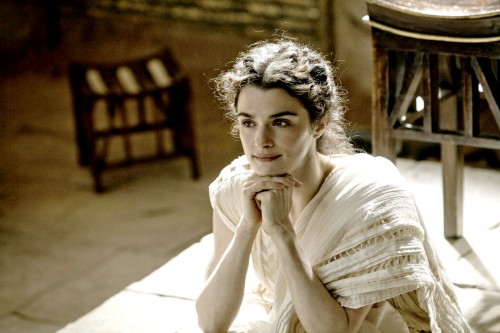
|
 AD 415 - Hypatia stoned to death, Alexandria (Egypt). Hypatia [c350–415] was an Egyptian Neoplatonist philosopher & the first notable woman in mathematics. As head of the Platonist school at Alexandria, she also taught philosophy & astronomy. She lived in Roman Egypt & was murdered by a Christian mob which accused her of causing religious turmoil. Kathleen Wilder proposes that the murder of Hypatia marked the end of Classical antiquity, while Maria Dzielska & Christian Wildberg note that Hellenistic philosophy continued to flourish in the 5th and 6th centuries, and perhaps until the age of Justinian." /// Image is scene from the film "Agora" staring Rachel Weisz as Hypatia. See "Lake Hypatia" in Alabama below. AD 415 - Hypatia stoned to death, Alexandria (Egypt). Hypatia [c350–415] was an Egyptian Neoplatonist philosopher & the first notable woman in mathematics. As head of the Platonist school at Alexandria, she also taught philosophy & astronomy. She lived in Roman Egypt & was murdered by a Christian mob which accused her of causing religious turmoil. Kathleen Wilder proposes that the murder of Hypatia marked the end of Classical antiquity, while Maria Dzielska & Christian Wildberg note that Hellenistic philosophy continued to flourish in the 5th and 6th centuries, and perhaps until the age of Justinian." /// Image is scene from the film "Agora" staring Rachel Weisz as Hypatia. See "Lake Hypatia" in Alabama below.
|


|
 October 27, 1553 - Servetus burned at the stake, Geneva (Switzerland). "Michael Servetus [1511-1553] was a Spanish theologian, physician, cartographer & humanist. He was the first European to correctly describe the function of pulmonary circulation. His interests included many sciences: mathematics, astronomy & meteorology, geography, human anatomy, medicine & pharmacology, as well as jurisprudence, & the scholarly study of the Bible in its original languages. He is renowned in the history of several of these fields, particularly medicine & theology. He participated in the Protestant Reformation, & later developed a nontrinitarian Christology. Condemned by Catholics & Protestants alike, he was arrested in Geneva and burnt at the stake as a heretic by order of the Protestant Geneva governing council." /// See 1903, 1908 & 1911 monuments in Geneva & France. /// Image shows "house of Michael Servetus in Villanueva de Sigena (Spain). Nowadays it is the headquarters of the Michael Servetus Institute & a research centre of Servetus' life and works." October 27, 1553 - Servetus burned at the stake, Geneva (Switzerland). "Michael Servetus [1511-1553] was a Spanish theologian, physician, cartographer & humanist. He was the first European to correctly describe the function of pulmonary circulation. His interests included many sciences: mathematics, astronomy & meteorology, geography, human anatomy, medicine & pharmacology, as well as jurisprudence, & the scholarly study of the Bible in its original languages. He is renowned in the history of several of these fields, particularly medicine & theology. He participated in the Protestant Reformation, & later developed a nontrinitarian Christology. Condemned by Catholics & Protestants alike, he was arrested in Geneva and burnt at the stake as a heretic by order of the Protestant Geneva governing council." /// See 1903, 1908 & 1911 monuments in Geneva & France. /// Image shows "house of Michael Servetus in Villanueva de Sigena (Spain). Nowadays it is the headquarters of the Michael Servetus Institute & a research centre of Servetus' life and works." 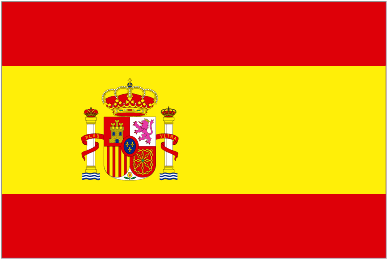
|

| S
YM
B
O
L | 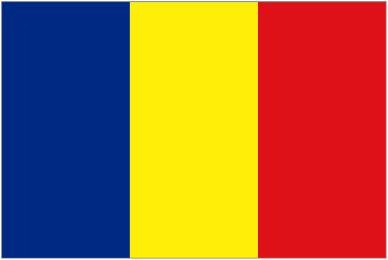 1568? - Symbol of Transylvanian Unitarianism (Romania). "The Unitarian Church of Transylvania (Erdélyi Unitárius Egyhaz or Biserica Unitariana din Transilvania) is a church of the Unitarian denomination, based in the city of Cluj in the Principality of Transylvania (Romania). Founded in 1568 inside Transylvania, it has a majority-Hungarian following." 1568? - Symbol of Transylvanian Unitarianism (Romania). "The Unitarian Church of Transylvania (Erdélyi Unitárius Egyhaz or Biserica Unitariana din Transilvania) is a church of the Unitarian denomination, based in the city of Cluj in the Principality of Transylvania (Romania). Founded in 1568 inside Transylvania, it has a majority-Hungarian following."
|
1600
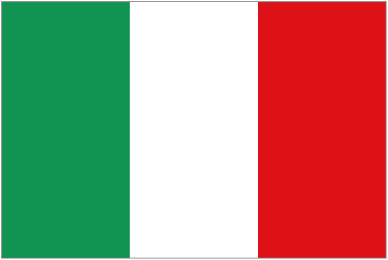 February 17, 1600 - This date is "considered the beginning of the era of modern freethought, as it is marked by the execution in Italy of Giordano Bruno [1548-1600], a former Dominican Monk, by the Inquisition."
February 17, 1600 - This date is "considered the beginning of the era of modern freethought, as it is marked by the execution in Italy of Giordano Bruno [1548-1600], a former Dominican Monk, by the Inquisition."
 October 25, 1600 - Historically the term "Unitarian" first appeared as "unitaria religio" in a document of the Diet of Lécfalva, Transylvania, on 25 Oct. 1600, though it was not widely used in Transylvania till 1638, when the formal recepta Unitaria Religio was published. The Polish Brethren or Socinians did not adopt the name, perhaps because of their differences with the Transylvanian Unitarians, but Christopher Sandius [1644-1680] in 1668 entitled his publication of their works: Bibliotheca Fratrum Polonorum quos Unitarios vocant (Library of the Polish Brethren who are called Unitarians 4 vols. 1665–1669).
October 25, 1600 - Historically the term "Unitarian" first appeared as "unitaria religio" in a document of the Diet of Lécfalva, Transylvania, on 25 Oct. 1600, though it was not widely used in Transylvania till 1638, when the formal recepta Unitaria Religio was published. The Polish Brethren or Socinians did not adopt the name, perhaps because of their differences with the Transylvanian Unitarians, but Christopher Sandius [1644-1680] in 1668 entitled his publication of their works: Bibliotheca Fratrum Polonorum quos Unitarios vocant (Library of the Polish Brethren who are called Unitarians 4 vols. 1665–1669).
 1662. - After the restoration of the Stuart monarchy and the resulting Act of Uniformity 1662, around 2000 ministers left the established Church of England. Following the Act of Toleration 1689 many of these ministers preached in 'non-conforming' congregations. The modern Unitarian denomination’s origins lay within this group of respectable Protestants who were reluctant to ever become ’Dissenters,’ i.e. the English Presbyterians.
1662. - After the restoration of the Stuart monarchy and the resulting Act of Uniformity 1662, around 2000 ministers left the established Church of England. Following the Act of Toleration 1689 many of these ministers preached in 'non-conforming' congregations. The modern Unitarian denomination’s origins lay within this group of respectable Protestants who were reluctant to ever become ’Dissenters,’ i.e. the English Presbyterians.

| C
H
A
P
E
L |  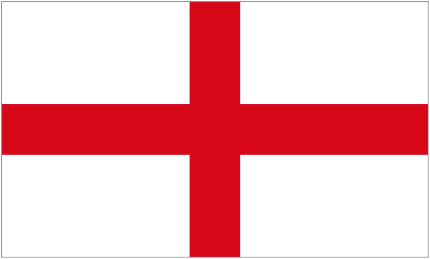 1662 - Cross Street Chapel - Unitarian, Manchester (England). "Dissenters' Meeting House" opened in 1694, but "the congregation dates from 1662 - the year of the Act of Uniformity. This act required all clergymen to abide stricly by the requirements of the Book of Common Prayer. Some 2000 clergymen refused, and were ejected from their livings. One of them was Rev. Henry Newcome [1627-1695], whose followers eventually built a place of worship of their own, the first of its kind in Manchester. This Dissenters' Meeting House, later to be known as Cross Street Chapel - Unitarian, was opened in 1694 and is the parent church of non-conformity in Manchester. The original chapel was destroyed by enemy action in 1940. Its 1959 replacement was succeeded in 1997 by our new suite of premises (the first two floors of a modern office block), designed to meet the needs of the 21st century.
/// Among those associated with the Chapel in the past, we remember particularly the novelist Elizabeth Gaskell [1810-1865] whose husband William was minister for 56 years [1828-1884]. The Gaskell Society continues to meet here regularly. The Gaskell Room in the Chapel has a collection of memorabilia including early editions of her novels." 1662 - Cross Street Chapel - Unitarian, Manchester (England). "Dissenters' Meeting House" opened in 1694, but "the congregation dates from 1662 - the year of the Act of Uniformity. This act required all clergymen to abide stricly by the requirements of the Book of Common Prayer. Some 2000 clergymen refused, and were ejected from their livings. One of them was Rev. Henry Newcome [1627-1695], whose followers eventually built a place of worship of their own, the first of its kind in Manchester. This Dissenters' Meeting House, later to be known as Cross Street Chapel - Unitarian, was opened in 1694 and is the parent church of non-conformity in Manchester. The original chapel was destroyed by enemy action in 1940. Its 1959 replacement was succeeded in 1997 by our new suite of premises (the first two floors of a modern office block), designed to meet the needs of the 21st century.
/// Among those associated with the Chapel in the past, we remember particularly the novelist Elizabeth Gaskell [1810-1865] whose husband William was minister for 56 years [1828-1884]. The Gaskell Society continues to meet here regularly. The Gaskell Room in the Chapel has a collection of memorabilia including early editions of her novels."
|

| C
H
A
P
E
L |   1672 - Brook Street Unitarian Chapel, Knutsford, Cheshire(England). Gathered 1672.
Built Circa 1694. The origins of Brook Street Chapel lie in the "Great Ejection" of nearly 2000 ministers from the Church of England in 1662. They could not in good conscience, agree to the Act of Uniformity and the new Prayer Book. Two "dissenting" ministers were registered in Knutsford in 1672 as Presbyterian preachers. In 1687, William Tong became minister. He stayed only two years, but was active together with Isaac Antobus in getting the new chapel built. 1672 - Brook Street Unitarian Chapel, Knutsford, Cheshire(England). Gathered 1672.
Built Circa 1694. The origins of Brook Street Chapel lie in the "Great Ejection" of nearly 2000 ministers from the Church of England in 1662. They could not in good conscience, agree to the Act of Uniformity and the new Prayer Book. Two "dissenting" ministers were registered in Knutsford in 1672 as Presbyterian preachers. In 1687, William Tong became minister. He stayed only two years, but was active together with Isaac Antobus in getting the new chapel built.
|
 1673. - The name "Unitarian" is introduced into English in 1673 by the Socinian Henry Hedworth [1626-1705].
1673. - The name "Unitarian" is introduced into English in 1673 by the Socinian Henry Hedworth [1626-1705].
 | C
HU
R
C
H |   1686 - King's Chapel, Boston, Massachusetts (USA). "The first Anglican Church in New England, and in 1785 it became the first Unitarian Church in America. Today the church has a Unitarian theology and an Anglican form of liturgy. It was originally housed in a wooden building dedicated on June 30, 1689. A growing congregation found this building in disrepair by the mid 18th century, so they acquired additional land, and hired architect Peter Harrison of Newport, Rhode Island to design a new and larger structure." 1686 - King's Chapel, Boston, Massachusetts (USA). "The first Anglican Church in New England, and in 1785 it became the first Unitarian Church in America. Today the church has a Unitarian theology and an Anglican form of liturgy. It was originally housed in a wooden building dedicated on June 30, 1689. A growing congregation found this building in disrepair by the mid 18th century, so they acquired additional land, and hired architect Peter Harrison of Newport, Rhode Island to design a new and larger structure."
|
 1697. The term free-thinker emerged toward the end of the 17th century in England to describe those who stood in opposition to the institution of the Church, and of literal belief in the Bible. The beliefs of these individuals were centered on the concept that people could understand the world through consideration of nature. Freethought positions were formally documented for the first time in 1697 by William Molyneux [1656-1698] in a widely publicized letter to John Locke, and more extensively in 1713, when Anthony Collins [1676-1729] wrote his "Discourse of Free-Thinking," which gained substantial popularity.
1697. The term free-thinker emerged toward the end of the 17th century in England to describe those who stood in opposition to the institution of the Church, and of literal belief in the Bible. The beliefs of these individuals were centered on the concept that people could understand the world through consideration of nature. Freethought positions were formally documented for the first time in 1697 by William Molyneux [1656-1698] in a widely publicized letter to John Locke, and more extensively in 1713, when Anthony Collins [1676-1729] wrote his "Discourse of Free-Thinking," which gained substantial popularity.
1700
 | C
HU
R
C
H |   1732 - Hollis Street Church, Boston, Massachusetts (USA).
Was Congregational (1732-c1800) and then Unitarian (c1800-1887). Ministers included: Mather Byles (1732-1777); Ebenezer Wight (1778-1788); Samuel West (1789-1808); Horace Holley (1809-1818); John Pierpont (1819-1845); David Fosdick (1846-1847); Thomas Starr King (1848-1860); George Leonard Chaney (1862-1877); Henry Bernard Carpenter (1878-1887). A fire destroyed the church building in 1787. The replacement in 1788 (as shown by the image) was the first building of Charles Bulfinch [1763-1844] who later became the architect of the US Capitol. The Hollis Street Church merged with the South Congregational Society of Boston in 1887. 1732 - Hollis Street Church, Boston, Massachusetts (USA).
Was Congregational (1732-c1800) and then Unitarian (c1800-1887). Ministers included: Mather Byles (1732-1777); Ebenezer Wight (1778-1788); Samuel West (1789-1808); Horace Holley (1809-1818); John Pierpont (1819-1845); David Fosdick (1846-1847); Thomas Starr King (1848-1860); George Leonard Chaney (1862-1877); Henry Bernard Carpenter (1878-1887). A fire destroyed the church building in 1787. The replacement in 1788 (as shown by the image) was the first building of Charles Bulfinch [1763-1844] who later became the architect of the US Capitol. The Hollis Street Church merged with the South Congregational Society of Boston in 1887.
|

| C
HU
R
C
H |   1754 - King's Chapel, 64 Beacon Street (School & Tremont Streets), Boston, Massachusetts (USA). "Organized as an Anglican congregation on June 15, 1686. First house of worship was a small wooden meeting house where the church stands today, dedicated on June 30, 1689.
A larger building was opened in 1754. Closed in 1776 following the exile of Royalists in March, but reopened for the funeral of Patriot General Joseph Warren [1741-1775] who was killed at the Battle of Bunker Hill. No minister until James Freeman [1759-1835] was hired as lay reader in 1782 and became minister in 1783. He introduced Unitarian ideas in his preaching and revised the Anglican Book of Common Prayer along Unitarian principles.
King's Chapel continues to follow a form of the Anglican liturgy, using the 9th edition of the "Book of Common Prayer According to the Use in King's Chapel" published in 1986. King's Chapel is now an 'independent congregation affiliated with the Unitarian Universalist Association of Congregations (UUA).'" 1754 - King's Chapel, 64 Beacon Street (School & Tremont Streets), Boston, Massachusetts (USA). "Organized as an Anglican congregation on June 15, 1686. First house of worship was a small wooden meeting house where the church stands today, dedicated on June 30, 1689.
A larger building was opened in 1754. Closed in 1776 following the exile of Royalists in March, but reopened for the funeral of Patriot General Joseph Warren [1741-1775] who was killed at the Battle of Bunker Hill. No minister until James Freeman [1759-1835] was hired as lay reader in 1782 and became minister in 1783. He introduced Unitarian ideas in his preaching and revised the Anglican Book of Common Prayer along Unitarian principles.
King's Chapel continues to follow a form of the Anglican liturgy, using the 9th edition of the "Book of Common Prayer According to the Use in King's Chapel" published in 1986. King's Chapel is now an 'independent congregation affiliated with the Unitarian Universalist Association of Congregations (UUA).'" 
|
 1765. In France, the freethought concept first appeared in publication in 1765 when Denis Diderot, Jean le Rond d'Alembert and Voltaire included an article on Libre-Penseur in their Encyclopédie. The European freethought concepts spread so widely that even places as remote as the Jotunheimen, in Norway, had well-known freethinkers, such as Jo Gjende, by the 19th century.
1765. In France, the freethought concept first appeared in publication in 1765 when Denis Diderot, Jean le Rond d'Alembert and Voltaire included an article on Libre-Penseur in their Encyclopédie. The European freethought concepts spread so widely that even places as remote as the Jotunheimen, in Norway, had well-known freethinkers, such as Jo Gjende, by the 19th century.
 | H
OU
S
E |   1770 - "The Old Manse," Concord, Massachusetts (USA). Built for "Rev. William Emerson [1769-1811], "one of Boston's leading citizens, a liberal-minded Unitarian minister, pastor to Boston's First Church and founder of its Philosophical Society, Anthology Club, and Boston Athenaeum, and father to Ralph Waldo Emerson [1803-1882]." He watched the Battle of Concord [April 19, 1775] from here. The house was "also home to Nathaniel Hawthorne [1804-1864] for a period. To the left of the house (not shown in this photo) is a small vegetable garden originally planted for Hawthorne by Henry David Thoreau [1817-1862]." 1770 - "The Old Manse," Concord, Massachusetts (USA). Built for "Rev. William Emerson [1769-1811], "one of Boston's leading citizens, a liberal-minded Unitarian minister, pastor to Boston's First Church and founder of its Philosophical Society, Anthology Club, and Boston Athenaeum, and father to Ralph Waldo Emerson [1803-1882]." He watched the Battle of Concord [April 19, 1775] from here. The house was "also home to Nathaniel Hawthorne [1804-1864] for a period. To the left of the house (not shown in this photo) is a small vegetable garden originally planted for Hawthorne by Henry David Thoreau [1817-1862]."
|
 1774. - The Unitarian movement gained popularity in the wake of the Enlightenment and, began to become a formal denomination in England in 1774 when Theophilus Lindsey organised meetings with Joseph Priestley. Unitarianism was not fully legal in the United Kingdom until the Doctrine of the Trinity Act 1813.
1774. - The Unitarian movement gained popularity in the wake of the Enlightenment and, began to become a formal denomination in England in 1774 when Theophilus Lindsey organised meetings with Joseph Priestley. Unitarianism was not fully legal in the United Kingdom until the Doctrine of the Trinity Act 1813.
 1774. Hosea Ballou has been called the "father of American Universalism," along with John Murray (minister), who founded the first Universalist church in America in Gloucester, Massachusetts, in 1774. The first General Society [of Univeraalists] was held in 1778.
1774. Hosea Ballou has been called the "father of American Universalism," along with John Murray (minister), who founded the first Universalist church in America in Gloucester, Massachusetts, in 1774. The first General Society [of Univeraalists] was held in 1778.

| C
HU
R
C
H |   1780 - Independent Christian Church, Universalist, 10 Church Street, Gloucester, Massachusetts (USA). A simple clapboard building with a 100-foot spire. It’s an unusual name for a Unitarian Universalist church. But there’s a lot about this church that’s unusual. The church is the oldest Universalist congregation in America.
"The writings of James Relly [c1722-1778], an English theologian who taught that Jesus’ death had saved everyone, found a receptive audience in Gloucester. Some members of First Parish, the town’s only church, formed a group in the 1770's to discuss these ideas, meeting at the home of Winthrop Sargent [1727-1793], a leading merchant and intellectual -- and father of Judith Sargent Murray [1751-1820]. This group would later leave First Parish to form a Universalist congregation.
When the Gloucester coterie heard that John Murray [1741-1815] was preaching in Boston, they invited him to visit—and persuaded him to stay on as their minister."
"Fifteen years ago, the building was in a state of decline and was sustained by an aging congregation of 16 active members. Today the church counts 118 members... The original 1780 building was replaced in 1806 by the building used today [as show in the image]." 1780 - Independent Christian Church, Universalist, 10 Church Street, Gloucester, Massachusetts (USA). A simple clapboard building with a 100-foot spire. It’s an unusual name for a Unitarian Universalist church. But there’s a lot about this church that’s unusual. The church is the oldest Universalist congregation in America.
"The writings of James Relly [c1722-1778], an English theologian who taught that Jesus’ death had saved everyone, found a receptive audience in Gloucester. Some members of First Parish, the town’s only church, formed a group in the 1770's to discuss these ideas, meeting at the home of Winthrop Sargent [1727-1793], a leading merchant and intellectual -- and father of Judith Sargent Murray [1751-1820]. This group would later leave First Parish to form a Universalist congregation.
When the Gloucester coterie heard that John Murray [1741-1815] was preaching in Boston, they invited him to visit—and persuaded him to stay on as their minister."
"Fifteen years ago, the building was in a state of decline and was sustained by an aging congregation of 16 active members. Today the church counts 118 members... The original 1780 building was replaced in 1806 by the building used today [as show in the image]."
|
 1785. Annual conventions [of Universalists] start in 1785 with the New England Convention. (In 1804, this convention changed its name to "The General Convention of Universalists in the New England States & Others.") By Massachusetts state law, citizens were taxed to support the Congregational Church of the community where they lived. Sixty-one people in Gloucester left the church to form the Independent Church of Christ, which stood for Universalism. They then refused to pay their taxes. The church they built was seized and sold to pay; however, the Church sued, and in 1786, they won their case.
1785. Annual conventions [of Universalists] start in 1785 with the New England Convention. (In 1804, this convention changed its name to "The General Convention of Universalists in the New England States & Others.") By Massachusetts state law, citizens were taxed to support the Congregational Church of the community where they lived. Sixty-one people in Gloucester left the church to form the Independent Church of Christ, which stood for Universalism. They then refused to pay their taxes. The church they built was seized and sold to pay; however, the Church sued, and in 1786, they won their case.

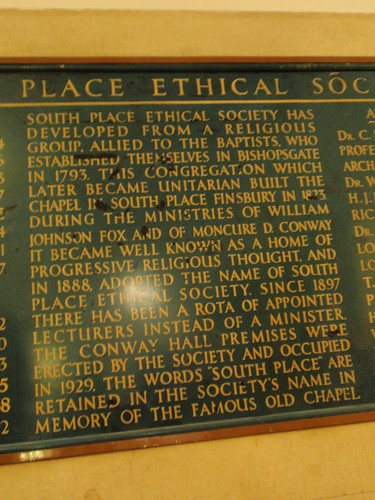
 |
  1787. South Place Ethical Society (SPES), Conway Hall, 25 Red Lion Square, Holborn, London (England). "Began as a dissident congregation in rebellion against the doctrine of eternal hell. By 1793 it had its first premises in Bishopsgate. The next step was rejection of the Trinity - which lost the Society many of its members. It survived the loss, however, & has since survived many similar losses of membership following similar progressive steps on the road from universalism & unitarianism to the present humanist position, which it had reached by the end of the 19th century." /// "The oldest freethought community in the world. Began as a group of nonconformists known as Philadelphians or Universalists." Hall named for American Moncure Conway [1832-1907] "who led the society 1864-1885 and 1892-1897, during which time it moved further away from Unitarianism." 1787. South Place Ethical Society (SPES), Conway Hall, 25 Red Lion Square, Holborn, London (England). "Began as a dissident congregation in rebellion against the doctrine of eternal hell. By 1793 it had its first premises in Bishopsgate. The next step was rejection of the Trinity - which lost the Society many of its members. It survived the loss, however, & has since survived many similar losses of membership following similar progressive steps on the road from universalism & unitarianism to the present humanist position, which it had reached by the end of the 19th century." /// "The oldest freethought community in the world. Began as a group of nonconformists known as Philadelphians or Universalists." Hall named for American Moncure Conway [1832-1907] "who led the society 1864-1885 and 1892-1897, during which time it moved further away from Unitarianism." 
|

| C
HU
R
C
H |   1787 - Unitarian Church, 4 Archdale Street, Charleston, South Carolina (USA). A National Historic Landmark. "The oldest Unitarian church in the South. In colonial Charleston, members of the Circular Congregational Church (then known as the Independent Church) were so numerous the need arose to build a second church building. Construction began at this Archdale site in 1772, but was temporarily interrupted by the Revolutionary War. The small rectangular brick church was finally completed in 1787. In 1817, the Archdale congregation was chartered as the Second Independent Church, with a Unitarian minister presiding. As the American Unitarian Association (AUA) was not organized until 1825, it was not until 1839 that this congregation was rechartered as Unitarian. The church received a major remodeling in the mid-19th century." 1787 - Unitarian Church, 4 Archdale Street, Charleston, South Carolina (USA). A National Historic Landmark. "The oldest Unitarian church in the South. In colonial Charleston, members of the Circular Congregational Church (then known as the Independent Church) were so numerous the need arose to build a second church building. Construction began at this Archdale site in 1772, but was temporarily interrupted by the Revolutionary War. The small rectangular brick church was finally completed in 1787. In 1817, the Archdale congregation was chartered as the Second Independent Church, with a Unitarian minister presiding. As the American Unitarian Association (AUA) was not organized until 1825, it was not until 1839 that this congregation was rechartered as Unitarian. The church received a major remodeling in the mid-19th century."
|
 1793. Universalists "organize."
1793. Universalists "organize."
1800
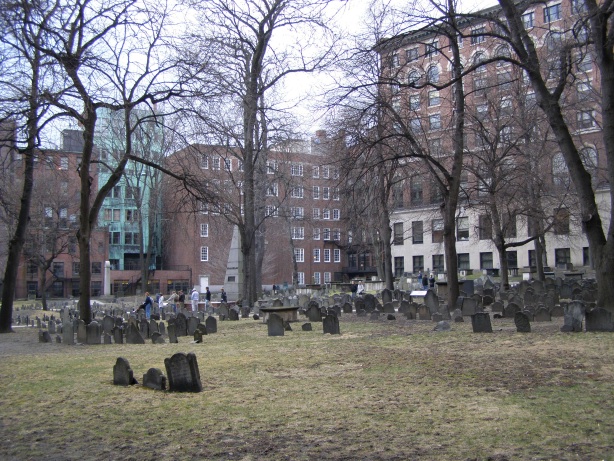
| G
RA
V
E |   1815 - Grave of John Murray,
Granary Burial Ground, Boston, Massachusetts (USA). According to Wikipedia, Rev. John Murray [1741-1815] is "sometimes recalled as founder of the Universalist denomination in the USA [but] might more fairly be described as a pioneer minister and an inspirational figure, as his theological legacy to the later Universalist denomination was minimal." 1815 - Grave of John Murray,
Granary Burial Ground, Boston, Massachusetts (USA). According to Wikipedia, Rev. John Murray [1741-1815] is "sometimes recalled as founder of the Universalist denomination in the USA [but] might more fairly be described as a pioneer minister and an inspirational figure, as his theological legacy to the later Universalist denomination was minimal."
|
 1815-1848. In Germany, during the period (1815–1848) and before the Revolution of March 1848, the resistance of citizens against the dogma of the church increased. In 1844, under the influence of Johannes Ronge [1813-1887] and Robert Blum, belief in the rights of man, tolerance among men, and humanism grew, and by 1859 they had established the Bund Freireligiöser Gemeinden Deutschlands (Union of Secular Communities in Germany). This union still exists today, and is included as a member in the umbrella organization of free humanists.
1815-1848. In Germany, during the period (1815–1848) and before the Revolution of March 1848, the resistance of citizens against the dogma of the church increased. In 1844, under the influence of Johannes Ronge [1813-1887] and Robert Blum, belief in the rights of man, tolerance among men, and humanism grew, and by 1859 they had established the Bund Freireligiöser Gemeinden Deutschlands (Union of Secular Communities in Germany). This union still exists today, and is included as a member in the umbrella organization of free humanists.


 | S
E
R
M
O
N |   May 5, 1819 - "Unitarian Christianity" sermon, First Independent Church of Baltimore (now First Unitarian Church of Baltimore, Baltimore, Maryland (USA). Also known as the "Baltimore Sermon."
By William Ellery Channing [1780-1842]. "An address composed with an acute awareness of its potential historical significance. That it lived up to that potential - to be the single most important sermon in Unitarian history - seems to have been confirmed by historical consensus. Both the time of the sermon & the occasion which prompted it gave it significance. In 1819, the theological battle between the Calvinists & the liberals had reached its greatest intensity, & the liberals were beginning to assert their independence & to accept, however reluctantly, the label 'Unitarian.' Channing's sermon was the signal that the name had not only been accepted, but seized & affirmed. Moreover, Channing's preaching the sermon at a new liberal church outside Boston signaled the intention of the Unitarians to make theirs a national movement. Six years later, in 1825, the American Unitarian Association would be founded." May 5, 1819 - "Unitarian Christianity" sermon, First Independent Church of Baltimore (now First Unitarian Church of Baltimore, Baltimore, Maryland (USA). Also known as the "Baltimore Sermon."
By William Ellery Channing [1780-1842]. "An address composed with an acute awareness of its potential historical significance. That it lived up to that potential - to be the single most important sermon in Unitarian history - seems to have been confirmed by historical consensus. Both the time of the sermon & the occasion which prompted it gave it significance. In 1819, the theological battle between the Calvinists & the liberals had reached its greatest intensity, & the liberals were beginning to assert their independence & to accept, however reluctantly, the label 'Unitarian.' Channing's sermon was the signal that the name had not only been accepted, but seized & affirmed. Moreover, Channing's preaching the sermon at a new liberal church outside Boston signaled the intention of the Unitarians to make theirs a national movement. Six years later, in 1825, the American Unitarian Association would be founded."
|


 | G
RA
V
E |   1820 - Grave of Judith Sargent Murray, Bingaman Cemetery, Natchez, Mississippi (USA). Cemetery is across St. Catherine Creek from the Grand Village of the Natchez Indians but is not being maintained. This is only readable marker. Judith Sargent Murray [1751-1820] was an "Author, Feminist & Religious Educator. The oldest child of Winthrop and Judith Saunders Sargent, Judith grew up as an avid reader and self-described "scribbler." She first married John Stevens, with whom she adopted two daughters. Her concern for their religious education led her to begin writing Universalist materials for children. After the death of John Stevens, Judith married Universalist minister John Murray [1741-1815]. Judith helped spread Universalism in the USA, along with promoting women's rights through publications like her "On the Equality of the Sexes," a short essay stressing the importance of education for women and appreciation of women's intellects. At the age of forty-one, she gave birth to Julia Maria Murray. She continued writing poetry, essays, and religious materials while teaching her daughter as well as various other children in her home. After John Murray's death in 1815, Judith moved to Mississippi to live with Julia Maria and her husband, Adam Lewis Bingaman [c1790-1869], at Fatherland, the Bingaman plantation near Natchez." 1820 - Grave of Judith Sargent Murray, Bingaman Cemetery, Natchez, Mississippi (USA). Cemetery is across St. Catherine Creek from the Grand Village of the Natchez Indians but is not being maintained. This is only readable marker. Judith Sargent Murray [1751-1820] was an "Author, Feminist & Religious Educator. The oldest child of Winthrop and Judith Saunders Sargent, Judith grew up as an avid reader and self-described "scribbler." She first married John Stevens, with whom she adopted two daughters. Her concern for their religious education led her to begin writing Universalist materials for children. After the death of John Stevens, Judith married Universalist minister John Murray [1741-1815]. Judith helped spread Universalism in the USA, along with promoting women's rights through publications like her "On the Equality of the Sexes," a short essay stressing the importance of education for women and appreciation of women's intellects. At the age of forty-one, she gave birth to Julia Maria Murray. She continued writing poetry, essays, and religious materials while teaching her daughter as well as various other children in her home. After John Murray's death in 1815, Judith moved to Mississippi to live with Julia Maria and her husband, Adam Lewis Bingaman [c1790-1869], at Fatherland, the Bingaman plantation near Natchez." | February 2003 - Lower image is historical marker, Copiah-Lincoln Community College (Co-Lin), 11 Co-Lin Circle, Natchez, Mississippi (USA). Info courtesy of Judy Wiggins, Retired Humanities Coordinator,
Copiah-Lincoln Community College.
|
 1825 - Establistment of the American Unitarian Association (AUA). The AUA's official journal was the Christian Register (1821-1961).
1825 - Establistment of the American Unitarian Association (AUA). The AUA's official journal was the Christian Register (1821-1961).
 |   1825-1826 - New Harmony, Indiana (USA). "Robert Owen [1771-1858] tried at New Harmony to create a more perfect society through free education & the abolition of social classes & personal wealth. World-renowned scientists & educators settled in New Harmony. With the help of William Maclure [1763-1840], the Scottish geologist and businessman, they introduced vocation education, kindergarten & other educational reforms.
New Harmony is also the site of the early headquarters of the US Geological Survey & provided the earliest geological & natural science collections for the beginnings of the Smithsonian Institution. David Dale Owen [1807-1860] turned to geology under the influence of William Maclure. From 1830 until 1860 New Harmony was one of the most important training & research centers for the study of geology in America. Today, Historic New Harmony is a Unified Program of the University of Southern Indiana & the Division of Indiana State Museums & Historic Sites." 1825-1826 - New Harmony, Indiana (USA). "Robert Owen [1771-1858] tried at New Harmony to create a more perfect society through free education & the abolition of social classes & personal wealth. World-renowned scientists & educators settled in New Harmony. With the help of William Maclure [1763-1840], the Scottish geologist and businessman, they introduced vocation education, kindergarten & other educational reforms.
New Harmony is also the site of the early headquarters of the US Geological Survey & provided the earliest geological & natural science collections for the beginnings of the Smithsonian Institution. David Dale Owen [1807-1860] turned to geology under the influence of William Maclure. From 1830 until 1860 New Harmony was one of the most important training & research centers for the study of geology in America. Today, Historic New Harmony is a Unified Program of the University of Southern Indiana & the Division of Indiana State Museums & Historic Sites."
|

| C
HU
R
C
H |   December 7, 1826 - Community Church of New York Unitarian Universalist (CCNY), 40 East 35th Street, New York, New York (USA). "When the first building in our history was dedicated, William Cullen Bryant [1794-1878], a member of the congregation, wrote a hymn for the occasion, and
William Ellery Channing [1780-1842] preached one of his most celebrated sermons, 'Unitarian Christianity Most Favorable to Piety.' Dr. John Haynes Holmes [1879-1964] -- our minister from 1907 to 1949 -- called this address the 'dedication not of a building at all, but of the whole life and temper of an institution.' It seemed a radical sermon in those days -- a revolt against the theological creeds of the times -- in which Dr. Channing stressed the great ideal of religious freedom, which has remained fundamental in the life of The Community Church." Image shows modern building. December 7, 1826 - Community Church of New York Unitarian Universalist (CCNY), 40 East 35th Street, New York, New York (USA). "When the first building in our history was dedicated, William Cullen Bryant [1794-1878], a member of the congregation, wrote a hymn for the occasion, and
William Ellery Channing [1780-1842] preached one of his most celebrated sermons, 'Unitarian Christianity Most Favorable to Piety.' Dr. John Haynes Holmes [1879-1964] -- our minister from 1907 to 1949 -- called this address the 'dedication not of a building at all, but of the whole life and temper of an institution.' It seemed a radical sermon in those days -- a revolt against the theological creeds of the times -- in which Dr. Channing stressed the great ideal of religious freedom, which has remained fundamental in the life of The Community Church." Image shows modern building.
|

| C
HU
R
C
H |   1828 - United First Parish Church (Unitarian Universalist), Quincy, Massachusetts (USA). "First gathered in 1636 as a branch of Church in Boston (which started in 1633), First Parish was established as an independent Church in 1639. Known then simply as 'Ye Church of Braintry.' its establishment made it possible for the Town of Braintree to incorporate in 1640. 'Old Braintree' was later to become the City of Quincy and the Towns of Braintree, Randolph, and Holbrook. This magnificent edifice was designed by Alexander Parris and built of granite donated by John Adams. Now known as "The Church of Presidents" because John Adams [1735-1826] and John Quincy Adams [1767-1848] are buried in its its graveyard. Image from c1851-1854. 1828 - United First Parish Church (Unitarian Universalist), Quincy, Massachusetts (USA). "First gathered in 1636 as a branch of Church in Boston (which started in 1633), First Parish was established as an independent Church in 1639. Known then simply as 'Ye Church of Braintry.' its establishment made it possible for the Town of Braintree to incorporate in 1640. 'Old Braintree' was later to become the City of Quincy and the Towns of Braintree, Randolph, and Holbrook. This magnificent edifice was designed by Alexander Parris and built of granite donated by John Adams. Now known as "The Church of Presidents" because John Adams [1735-1826] and John Quincy Adams [1767-1848] are buried in its its graveyard. Image from c1851-1854.
|
 1830's. At its peak in the 1830's, the Universalist Church is reported to have been the 9th largest denomination in the United States.
1830's. At its peak in the 1830's, the Universalist Church is reported to have been the 9th largest denomination in the United States.
 1848. Transcendentalism began in 1848 as a protest against the general state of culture and society, and in particular, the state of intellectualism at Harvard and the doctrine of the Unitarian church taught at Harvard Divinity School. Among transcendentalists' core beliefs was an ideal spiritual state that "transcends" the physical and empirical and is realized only through the individual's intuition, rather than through the doctrines of established religions. Prominent transcendentalists included Ralph Waldo Emerson, Henry David Thoreau, Walt Whitman, Amos Bronson Alcott, Orestes Brownson, William Henry Channing, James Freeman Clarke, Christopher Pearse Cranch, John Sullivan Dwight, Convers Francis, Margaret Fuller, William Henry Furness, Frederick Henry Hedge, Theodore Parker, Elizabeth Peabody, George Ripley, and Jones Very.
1848. Transcendentalism began in 1848 as a protest against the general state of culture and society, and in particular, the state of intellectualism at Harvard and the doctrine of the Unitarian church taught at Harvard Divinity School. Among transcendentalists' core beliefs was an ideal spiritual state that "transcends" the physical and empirical and is realized only through the individual's intuition, rather than through the doctrines of established religions. Prominent transcendentalists included Ralph Waldo Emerson, Henry David Thoreau, Walt Whitman, Amos Bronson Alcott, Orestes Brownson, William Henry Channing, James Freeman Clarke, Christopher Pearse Cranch, John Sullivan Dwight, Convers Francis, Margaret Fuller, William Henry Furness, Frederick Henry Hedge, Theodore Parker, Elizabeth Peabody, George Ripley, and Jones Very.
 After 1848. Driven by the Revolutions of 1848 in the German states, the 19th century saw an immigration of German freethinkers and anti-clericalists to the United States (see "Forty-Eighters"). In the U.S., they hoped to be able to live by their principles, without interference from government and church authorities. Many Freethinkers settled in German immigrant strongholds, including St. Louis, Indianapolis, Wisconsin, and Texas, where they founded the town of Comfort, Texas, as well as others.
These groups of German Freethinkers referred to their organizations as Freie Gemeinden, or "free congregations." The first Freie Gemeinde was established in St. Louis in 1850. Others followed in Pennsylvania, California, Washington, D.C., New York, Illinois, Wisconsin, Texas, and other states.
Freethinkers tended to be liberal, espousing ideals such as racial, social, and sexual equality, and the abolition of slavery.
After 1848. Driven by the Revolutions of 1848 in the German states, the 19th century saw an immigration of German freethinkers and anti-clericalists to the United States (see "Forty-Eighters"). In the U.S., they hoped to be able to live by their principles, without interference from government and church authorities. Many Freethinkers settled in German immigrant strongholds, including St. Louis, Indianapolis, Wisconsin, and Texas, where they founded the town of Comfort, Texas, as well as others.
These groups of German Freethinkers referred to their organizations as Freie Gemeinden, or "free congregations." The first Freie Gemeinde was established in St. Louis in 1850. Others followed in Pennsylvania, California, Washington, D.C., New York, Illinois, Wisconsin, Texas, and other states.
Freethinkers tended to be liberal, espousing ideals such as racial, social, and sexual equality, and the abolition of slavery.
1850


 | C
HU
R
C
H |   1852 - Park Hall, Free Congregation of Sauk County, 307 Polk Street, Sauk City, Wisconsin (USA). "The longest continuously operating Freethought congregation in America. Founded in 1852 & still active today. Affiliated with the American Unitarian Association (now the Unitarian Universalist Association) in 1955." "A UU Fellowship...we are a Free Thought congregation with origins in the German Freie Gemeinden (’free congregations’ or ‘free societies’). When liberal reform efforts, both political and religious, failed in Germany after 1848, German liberals immigrated to the USA where they founded numerous free thought societies and congregations, most of them in the northeast and upper mid-west. One such German liberal, Eduard Schroeter [1811-1888], helped to found this congregation in 1852 and became its first Speaker (leader and teacher). Ours is the last remaining Free Congregation in North America." Image shows building constructd in 1884? 1852 - Park Hall, Free Congregation of Sauk County, 307 Polk Street, Sauk City, Wisconsin (USA). "The longest continuously operating Freethought congregation in America. Founded in 1852 & still active today. Affiliated with the American Unitarian Association (now the Unitarian Universalist Association) in 1955." "A UU Fellowship...we are a Free Thought congregation with origins in the German Freie Gemeinden (’free congregations’ or ‘free societies’). When liberal reform efforts, both political and religious, failed in Germany after 1848, German liberals immigrated to the USA where they founded numerous free thought societies and congregations, most of them in the northeast and upper mid-west. One such German liberal, Eduard Schroeter [1811-1888], helped to found this congregation in 1852 and became its first Speaker (leader and teacher). Ours is the last remaining Free Congregation in North America." Image shows building constructd in 1884? 
|
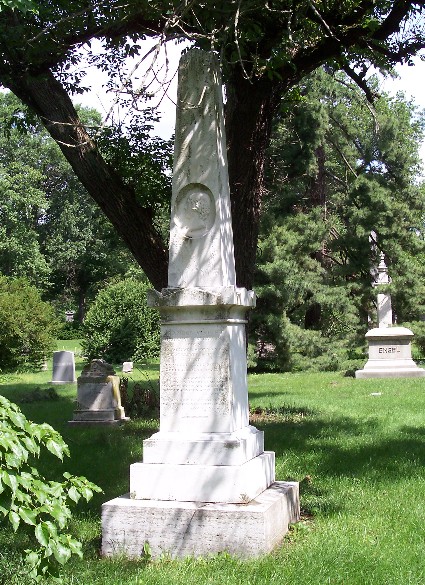


|   After 1852 - Grave of Frances Wright, Spring Grove Cemetery & Arboretum, 4521 Spring Grove Avenue, Cincinnati, Hamilton County
Ohio 45232 (USA). Frances (Fanny) Wright [1795-1852] was "a Scottish-born lecturer, writer, freethinker, feminist, abolitionist & social reformer, who became a US citizen in 1825. That year she founded the Nashoba Commune in Germantown, Tennessee, as a utopian community to prepare slaves for emancipation, intending to create an egalitarian place, but it lasted only three years. Her 'Views of Society & Manners in America' (1821) brought her the most attention as a critique of the new nation." Fny did many things: She was first woman in America to edit a journal & first American woman to give a popular lecture series before an audience of men & women. She visited Monticello with the Marquis de Lafayette, lived in New Harmony, Indiana, lectured in New York City, published a newspaper in Cincinnati, freed slaves in Haiti, bore one child out of wedlock & lived at La Grange, LaFayette's estate near Paris (France). After 1852 - Grave of Frances Wright, Spring Grove Cemetery & Arboretum, 4521 Spring Grove Avenue, Cincinnati, Hamilton County
Ohio 45232 (USA). Frances (Fanny) Wright [1795-1852] was "a Scottish-born lecturer, writer, freethinker, feminist, abolitionist & social reformer, who became a US citizen in 1825. That year she founded the Nashoba Commune in Germantown, Tennessee, as a utopian community to prepare slaves for emancipation, intending to create an egalitarian place, but it lasted only three years. Her 'Views of Society & Manners in America' (1821) brought her the most attention as a critique of the new nation." Fny did many things: She was first woman in America to edit a journal & first American woman to give a popular lecture series before an audience of men & women. She visited Monticello with the Marquis de Lafayette, lived in New Harmony, Indiana, lectured in New York City, published a newspaper in Cincinnati, freed slaves in Haiti, bore one child out of wedlock & lived at La Grange, LaFayette's estate near Paris (France).  
|    1950's - Nashoba Marker, Germantown, near Memphis, Tennessee (USA). 1950's - Nashoba Marker, Germantown, near Memphis, Tennessee (USA).
|
 About 1856. The Golden Age of Freethought describes the socio-political movement promoting freethought that developed in the mid 19th-century United States. It began around 1856 and lasted at least through the end of the century; author Susan Jacoby places the end of the Golden Age at the start of World War I [in 1914]. The Golden Age was encouraged by the lectures of the extremely popular agnostic orator Robert G. Ingersoll [1833-1899], the popularization of Charles Darwin’s "The Origin of Species," the push for woman’s suffrage, and other political, scientific, and social trends that clashed with religious orthodoxy and caused people to question their traditional ideas about the world.
About 1856. The Golden Age of Freethought describes the socio-political movement promoting freethought that developed in the mid 19th-century United States. It began around 1856 and lasted at least through the end of the century; author Susan Jacoby places the end of the Golden Age at the start of World War I [in 1914]. The Golden Age was encouraged by the lectures of the extremely popular agnostic orator Robert G. Ingersoll [1833-1899], the popularization of Charles Darwin’s "The Origin of Species," the push for woman’s suffrage, and other political, scientific, and social trends that clashed with religious orthodoxy and caused people to question their traditional ideas about the world.
 June 25, 1863. - Universalist Olympia Brown [1835-1926] becomes the first woman in the United States to receive ordination in a national denomination.
June 25, 1863. - Universalist Olympia Brown [1835-1926] becomes the first woman in the United States to receive ordination in a national denomination.
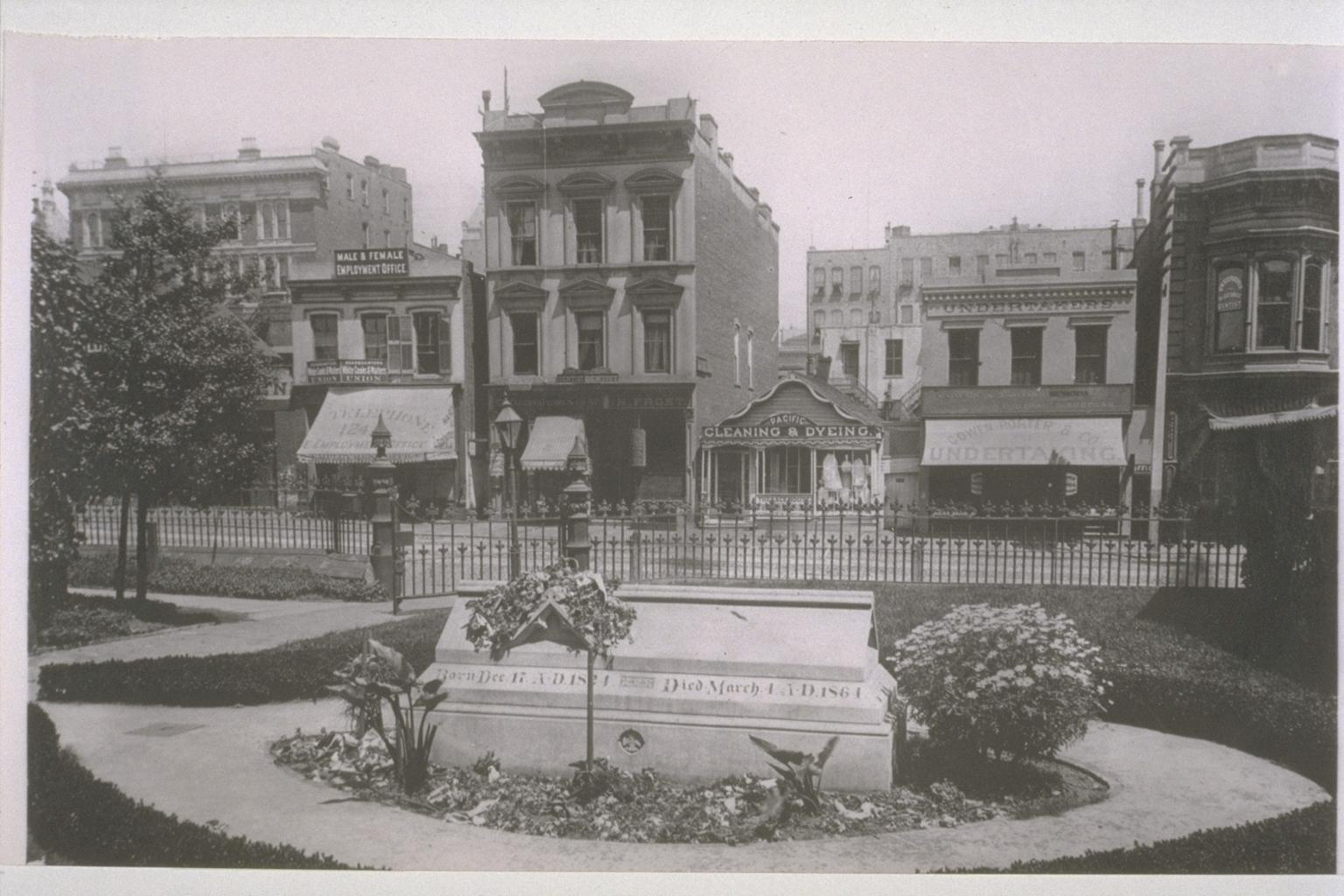

 | G
RA
V
E |   1864 - Grave of Thomas Starr King, First Unitarian Universalist Society, 1187 Franklin Street (corner of Geary Street), San Francisco, California (USA). Stone sarcophagus contains the earthly remains of Thomas Starr King [1824-1864], an American Unitarian minister, influential in California politics during the American Civil War. Statue of King (or a male mourner?) and two children added when? 1864 - Grave of Thomas Starr King, First Unitarian Universalist Society, 1187 Franklin Street (corner of Geary Street), San Francisco, California (USA). Stone sarcophagus contains the earthly remains of Thomas Starr King [1824-1864], an American Unitarian minister, influential in California politics during the American Civil War. Statue of King (or a male mourner?) and two children added when?
|
 After 1865. After the Civil War, the "Forty-Eighters" supported improved labor laws and working conditions. They also advanced the country's cultural and intellectual development in such fields as education, the arts, medicine, journalism, and business.
After 1865. After the Civil War, the "Forty-Eighters" supported improved labor laws and working conditions. They also advanced the country's cultural and intellectual development in such fields as education, the arts, medicine, journalism, and business.
 1866 - Establishment of the Universalist Church in America. "Known from 1866 as the Universalist General Convention, the name was changed to the Universalist Church of America in 1942. In 1961, it merged with the American Unitarian Association to form the Unitarian Universalist Association."
1866 - Establishment of the Universalist Church in America. "Known from 1866 as the Universalist General Convention, the name was changed to the Universalist Church of America in 1942. In 1961, it merged with the American Unitarian Association to form the Unitarian Universalist Association."
 1873. The earliest known secular organization in English Canada is the Toronto Freethought Association, founded in 1873 by a handful of secularists. Reorganized in 1877 and again in 1881, when it was renamed the Toronto Secular Society, the group formed the nucleus of the Canadian Secular Union, established in 1884 to bring together freethinkers from across the country.
1873. The earliest known secular organization in English Canada is the Toronto Freethought Association, founded in 1873 by a handful of secularists. Reorganized in 1877 and again in 1881, when it was renamed the Toronto Secular Society, the group formed the nucleus of the Canadian Secular Union, established in 1884 to bring together freethinkers from across the country.

| B
OO
K |   1876 - "The Burgess-Underwood Debate: Commencing June 29, 1875, at Aylmer, Ontario, and Continuing Four Days Between O. A. Burgess and B. F. Underwood" by John T. Hawke, published by D. M. Bennett.
Offered by National Book Auctions for estimated $22:
"Condition/Details: Bound in half leather with marbled boards, this antique volume is a scarce nineteenth-century political pamphlet. Title page states "reported by John T. Hawke." Benjamin Franklin Underwood [1839-1914], born in New York in July 1839, served in the Civil War and was a POW in Richmond for 9 months. He went on to become a lecturer, debater, and writer in the cause of Rationalism. He published several works of Freethought, now all very scarce. His sister, Sara A. Underwood, was the author of "Heroines of Freethought." Freethought pamphlets are rarely found in any condition, and this one is a scarce early D.M. Bennett imprint in remarkable condition, thanks to library preservation." 1876 - "The Burgess-Underwood Debate: Commencing June 29, 1875, at Aylmer, Ontario, and Continuing Four Days Between O. A. Burgess and B. F. Underwood" by John T. Hawke, published by D. M. Bennett.
Offered by National Book Auctions for estimated $22:
"Condition/Details: Bound in half leather with marbled boards, this antique volume is a scarce nineteenth-century political pamphlet. Title page states "reported by John T. Hawke." Benjamin Franklin Underwood [1839-1914], born in New York in July 1839, served in the Civil War and was a POW in Richmond for 9 months. He went on to become a lecturer, debater, and writer in the cause of Rationalism. He published several works of Freethought, now all very scarce. His sister, Sara A. Underwood, was the author of "Heroines of Freethought." Freethought pamphlets are rarely found in any condition, and this one is a scarce early D.M. Bennett imprint in remarkable condition, thanks to library preservation."
|
 1877 - Felix Adler [1851-1933], professor of political & social ethics, rationalist, popular lecturer, religious leader & social reformer, founds Ethical Culture movement. "Individual chapter organizations are generically referred to as "Ethical Societies", though their names may include "Ethical Society," "Ethical Culture Society," "Society for Ethical Culture," "Ethical Humanist Society," or other variations on the theme of "Ethical."
Ethical Culture is premised on the idea that honoring and living in accordance with ethical principles is central to what it takes to live meaningful and fulfilling lives, and to creating a world that is good for all. Practitioners of Ethical Culture focus on supporting one another in becoming better people, and on doing good in the world.
The American Ethical Union is a federation of about 25 Ethical Societies in the United States, representing the Ethical Culture movement. It is one of the founding member organizations of the International Humanist & Ethical Union."
1877 - Felix Adler [1851-1933], professor of political & social ethics, rationalist, popular lecturer, religious leader & social reformer, founds Ethical Culture movement. "Individual chapter organizations are generically referred to as "Ethical Societies", though their names may include "Ethical Society," "Ethical Culture Society," "Society for Ethical Culture," "Ethical Humanist Society," or other variations on the theme of "Ethical."
Ethical Culture is premised on the idea that honoring and living in accordance with ethical principles is central to what it takes to live meaningful and fulfilling lives, and to creating a world that is good for all. Practitioners of Ethical Culture focus on supporting one another in becoming better people, and on doing good in the world.
The American Ethical Union is a federation of about 25 Ethical Societies in the United States, representing the Ethical Culture movement. It is one of the founding member organizations of the International Humanist & Ethical Union."


Circa 1900:
 | 2
O
B
I
L
I
S
K
S | Oblisk on left:
  1879 - Robert Owen Memorial, Kensal Green Cemetery, London (England). Erected by committee under Joseph Corfield [1808-1888]. Robert Owen [1771-1858] developed utopian communities both in New Lanark (Scotland) and New Harmony, Indiana (USA). This is not his grave; he is buried in Newtown, Montgomeryshire (Wales). 1879 - Robert Owen Memorial, Kensal Green Cemetery, London (England). Erected by committee under Joseph Corfield [1808-1888]. Robert Owen [1771-1858] developed utopian communities both in New Lanark (Scotland) and New Harmony, Indiana (USA). This is not his grave; he is buried in Newtown, Montgomeryshire (Wales).
| Oblisk on right:
  August 1885 - Reformers Memorial, Kensal Green Cemetery, London (England).
Column of light stone inscribed "to the memory of the men and women who have generously given
their time and means to improve the conditions and enlarge the happiness of all classes of society."
Erected by Joseph William Corfield [1809-1888] of Abney Park, a Unitarian and member the South Place Ethical Society.
Displays "the names of 50 well-known reformers. Another 25 were added in 1907 on the instructions of Corfield's daughter Emma."
The first two names are Robert Owen [1771-1858] and John Bellers [1654-1725]. "The remaining 72
names include many well known social reformers, Christian Socialists,
Co-operators and political activists."
"Contested Sites: Commemoration, Memorial and Popular Politics in Nineteenth-Century Britain" (by Paul A. Pickering, Alex Tyrrell et al, May 2004) names 46 of the reformers. August 1885 - Reformers Memorial, Kensal Green Cemetery, London (England).
Column of light stone inscribed "to the memory of the men and women who have generously given
their time and means to improve the conditions and enlarge the happiness of all classes of society."
Erected by Joseph William Corfield [1809-1888] of Abney Park, a Unitarian and member the South Place Ethical Society.
Displays "the names of 50 well-known reformers. Another 25 were added in 1907 on the instructions of Corfield's daughter Emma."
The first two names are Robert Owen [1771-1858] and John Bellers [1654-1725]. "The remaining 72
names include many well known social reformers, Christian Socialists,
Co-operators and political activists."
"Contested Sites: Commemoration, Memorial and Popular Politics in Nineteenth-Century Britain" (by Paul A. Pickering, Alex Tyrrell et al, May 2004) names 46 of the reformers.
|
 1881. The Freethinker magazine was first published in Britain in 1881.
1881. The Freethinker magazine was first published in Britain in 1881.
 1881. In Frankfurt am Main, Ludwig Büchner established Deutschen Freidenkerbund (German Freethinkers League) as the first German organization for atheists. In 1892 the Freidenker-Gesellschaft and in 1906 the Deutscher Monistenbund were formed. Freethought organizations developed "Jugendweihe", secular "confirmation" ceremonies, and atheist funeral rites.
1881. In Frankfurt am Main, Ludwig Büchner established Deutschen Freidenkerbund (German Freethinkers League) as the first German organization for atheists. In 1892 the Freidenker-Gesellschaft and in 1906 the Deutscher Monistenbund were formed. Freethought organizations developed "Jugendweihe", secular "confirmation" ceremonies, and atheist funeral rites.


| P
A
I
N
T |   1885 - "Hypatia," Laing Art Gallery, Newcastle-on-Tyne (England). Painting by Charles William Mitchell [1854-1903], an English Pre-Raphaelite painter from Newcastle. It was "likely inspired by 'Hypatia or New Foes with an Old Face,' a serialized novel by Charles Kingsley [1819-1875]." As you can see he created the iconic as well as ironic painting of Hypatia in front of a Christian altar, the irony being that she was pagan." Hypatia [d. March 415] was "a Greek scholar from Alexandria (Egypt) considered to be the first notable female mathematician. She was assassinated by a Christian mob who accused her of causing religious turmoil." "She has become a symbol of martryed Reason, feminism & Classical paganism." 1885 - "Hypatia," Laing Art Gallery, Newcastle-on-Tyne (England). Painting by Charles William Mitchell [1854-1903], an English Pre-Raphaelite painter from Newcastle. It was "likely inspired by 'Hypatia or New Foes with an Old Face,' a serialized novel by Charles Kingsley [1819-1875]." As you can see he created the iconic as well as ironic painting of Hypatia in front of a Christian altar, the irony being that she was pagan." Hypatia [d. March 415] was "a Greek scholar from Alexandria (Egypt) considered to be the first notable female mathematician. She was assassinated by a Christian mob who accused her of causing religious turmoil." "She has become a symbol of martryed Reason, feminism & Classical paganism."
|



| C
HA
P
E
L |   1886 - Unity Chapel, Spring Green, Wisconsin (USA). "Built at the direction of the Reverend Jenkin Lloyd Jones [1843-1918], a son of the family who was also a prominent Unitarian minister in Chicago. The designer of record was Joseph Silsbee, who had designed buildings for Jenkin in Chicago, and a draughtsman assigned to the job was Jenkin's 18-year old nephew, Frank Lloyd Wright [1867-1959]." "This is arguably the first building that young Mr. Wright had any say in designing. He was said to have done some of the interior design." Jenkin Lloyd Jones organized the first Parliament of the World's Religions in 1893. He was General Secretary, 1994-1906, of the American Congress of Liberal Religion, an alliance of liberal Jews, Unitarians, Universalists, and Ethical Culturalists. (Their goal was a "Church of Humanity, democratic in organization, progressive in thought, cherishing the spiritual traditions and experiences of the past but keeping itself open to all new light.") He founded the Abraham Lincoln Centre in 1905 and sailed on Henry Ford's Peace Ship in 1918-19. Lower image is Jenkins' grave at the chapel. 1886 - Unity Chapel, Spring Green, Wisconsin (USA). "Built at the direction of the Reverend Jenkin Lloyd Jones [1843-1918], a son of the family who was also a prominent Unitarian minister in Chicago. The designer of record was Joseph Silsbee, who had designed buildings for Jenkin in Chicago, and a draughtsman assigned to the job was Jenkin's 18-year old nephew, Frank Lloyd Wright [1867-1959]." "This is arguably the first building that young Mr. Wright had any say in designing. He was said to have done some of the interior design." Jenkin Lloyd Jones organized the first Parliament of the World's Religions in 1893. He was General Secretary, 1994-1906, of the American Congress of Liberal Religion, an alliance of liberal Jews, Unitarians, Universalists, and Ethical Culturalists. (Their goal was a "Church of Humanity, democratic in organization, progressive in thought, cherishing the spiritual traditions and experiences of the past but keeping itself open to all new light.") He founded the Abraham Lincoln Centre in 1905 and sailed on Henry Ford's Peace Ship in 1918-19. Lower image is Jenkins' grave at the chapel.
|
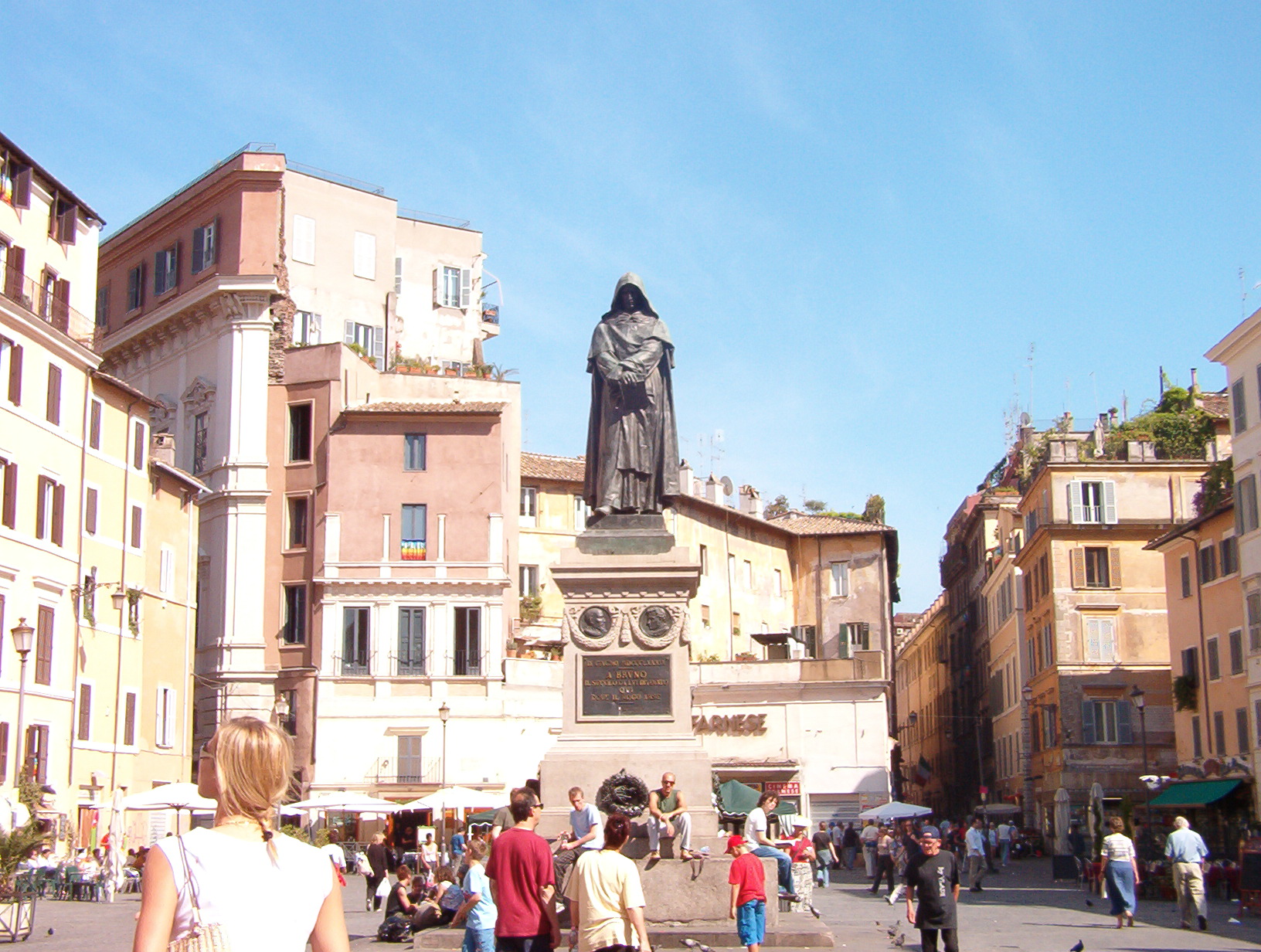
|
 June 9, 1889 - Statue of Giordano Bruno, Campo de' Fiori, Rome (Italy). At site where Bruno was burnt at the stake for heresy on February 17, 1600. On April 20, 1884, Pope Leo XIII published the encyclical Humanum Genus. As a response, the Freemasons decided to create a statue of pantheist Giordano Bruno [1548-1600], a Dominican friar, philosopher, mathematician, poet & astrologer. Bruno is now considered a pioneer of freethought & science. June 9, 1889 - Statue of Giordano Bruno, Campo de' Fiori, Rome (Italy). At site where Bruno was burnt at the stake for heresy on February 17, 1600. On April 20, 1884, Pope Leo XIII published the encyclical Humanum Genus. As a response, the Freemasons decided to create a statue of pantheist Giordano Bruno [1548-1600], a Dominican friar, philosopher, mathematician, poet & astrologer. Bruno is now considered a pioneer of freethought & science.
|
 About 1890. Freethought in the United States began to decline in the late nineteenth century. Its anti-religious views alienated would-be sympathizers. The movement also lacked cohesive goals or beliefs. By the early 20th century, most Freethought congregations had disbanded or joined other mainstream churches.
About 1890. Freethought in the United States began to decline in the late nineteenth century. Its anti-religious views alienated would-be sympathizers. The movement also lacked cohesive goals or beliefs. By the early 20th century, most Freethought congregations had disbanded or joined other mainstream churches.
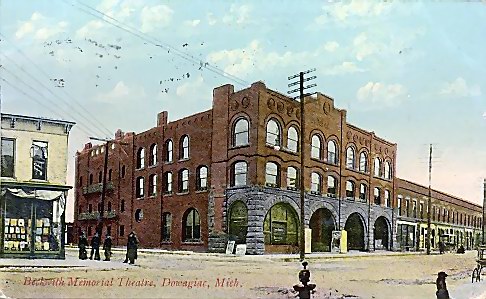



|   January 25, 1893 - Beckwith Memorial Theatre, Front & Beeson Streets, Dowagiac, Michigan (USA). Dedicated by Robert Ingersoll. Razed in 1968. Philo D. Beckwith [1835-1889] "was a committed freethinker who wanted to 'make the townsfolk aware & appreciative of those his personal pantheon of heroes & heroines whom he considered to be the true benefactors of the human race.'" /// In 1892 in memory of Beckwith, his daughter Kate & son-in-law, Fred Lee built the theatre (regarded as one of the finest between New York & Chicago). The building also contained a bank, city hall & Round Oak Company offices.
The building's exterior featured stone relief medallions of six famous women (e.g. Susan B. Anthony, Sarah Bernhardt, George Sand) &14 famous men (e.g. Beethoven, Chopin, Emerson,Victor Hugo, Robert Ingersoll, Liszt, Thomas Paine, Shakespeare, Walt Whitman, Shakespeare & Voltaire).
/// "When the building was razed in 1966 [sic], the busts were salvaged. Eight are today used in columns standing at the entrance to the Lyons Building at Southwestern Michigan College in Dowagiac." /// Right image shows the bust of Ingersoll in the Robert Green Ingersoll Birthplace Museum in Dresden, New York. January 25, 1893 - Beckwith Memorial Theatre, Front & Beeson Streets, Dowagiac, Michigan (USA). Dedicated by Robert Ingersoll. Razed in 1968. Philo D. Beckwith [1835-1889] "was a committed freethinker who wanted to 'make the townsfolk aware & appreciative of those his personal pantheon of heroes & heroines whom he considered to be the true benefactors of the human race.'" /// In 1892 in memory of Beckwith, his daughter Kate & son-in-law, Fred Lee built the theatre (regarded as one of the finest between New York & Chicago). The building also contained a bank, city hall & Round Oak Company offices.
The building's exterior featured stone relief medallions of six famous women (e.g. Susan B. Anthony, Sarah Bernhardt, George Sand) &14 famous men (e.g. Beethoven, Chopin, Emerson,Victor Hugo, Robert Ingersoll, Liszt, Thomas Paine, Shakespeare, Walt Whitman, Shakespeare & Voltaire).
/// "When the building was razed in 1966 [sic], the busts were salvaged. Eight are today used in columns standing at the entrance to the Lyons Building at Southwestern Michigan College in Dowagiac." /// Right image shows the bust of Ingersoll in the Robert Green Ingersoll Birthplace Museum in Dresden, New York.
|
 1890's. In the 1890's the American Unitarian Association began to allow non-Christian and non-theistic churches and individuals to be part of their fellowship. As a result, people who held no Unitarian belief began to be called "Unitarians," simply because they were members of churches that belonged to the American Unitarian Association. After several decades, the non-theistic members outnumbered the theological Unitarians.
1890's. In the 1890's the American Unitarian Association began to allow non-Christian and non-theistic churches and individuals to be part of their fellowship. As a result, people who held no Unitarian belief began to be called "Unitarians," simply because they were members of churches that belonged to the American Unitarian Association. After several decades, the non-theistic members outnumbered the theological Unitarians.

|   1898 - Das Dutsches Haus, Indianapolis, Indiana (USA). "A magnificent victory monument for a rational outlook on life." Built as a German-American Turnverein (clubhouse & community center) between 1894 & 1898. Bernard Vonnegut, Kurt Vonnegut, Jr.’s grandfather, was principal architect & builder... The so-called “Forty-Eighters,” political activists who were forced out of Germany after the failed revolution of 1848, brought a liberal mindset & political zeal to the Midwest & to Indianapolis. They founded the Turnverein, a gymnastics society that embodied the motto of Friedrich Jahn [1778-1852], the founder of the Turner movement in Germany: “A Sound Mind in a Sound Body.” Along with another motto inscribed on the building’s East Tower, "Frisch, Frei, Stark und Treu" (vibrant, free, strong and loyal), these words are lasting tributes to this influential group of liberal thinkers which included the Vonnegut family and other prominent German-Americans such as the Liebers.
In 1870, several of them founded the Freethinkers Society. 1898 - Das Dutsches Haus, Indianapolis, Indiana (USA). "A magnificent victory monument for a rational outlook on life." Built as a German-American Turnverein (clubhouse & community center) between 1894 & 1898. Bernard Vonnegut, Kurt Vonnegut, Jr.’s grandfather, was principal architect & builder... The so-called “Forty-Eighters,” political activists who were forced out of Germany after the failed revolution of 1848, brought a liberal mindset & political zeal to the Midwest & to Indianapolis. They founded the Turnverein, a gymnastics society that embodied the motto of Friedrich Jahn [1778-1852], the founder of the Turner movement in Germany: “A Sound Mind in a Sound Body.” Along with another motto inscribed on the building’s East Tower, "Frisch, Frei, Stark und Treu" (vibrant, free, strong and loyal), these words are lasting tributes to this influential group of liberal thinkers which included the Vonnegut family and other prominent German-Americans such as the Liebers.
In 1870, several of them founded the Freethinkers Society. 
|
 |   After July 21, 1899 - Grave of Robert Green Ingersoll [1833-1899], Arlington National Cemetery (Section 3, Grave 1620), Arlington, Virginia (USA). After July 21, 1899 - Grave of Robert Green Ingersoll [1833-1899], Arlington National Cemetery (Section 3, Grave 1620), Arlington, Virginia (USA).
|
1900
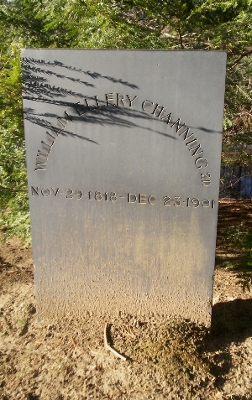
 | G
RA
V
E |   1901 - Grave of William Ellery Channing, Sleepy Hollow Cemetery, Concord, Massadchusetts (USA). This Willam Ellery Channing [1818-1901] is the husband of Margaret's Fuller's younger sister Ellen and the nephew of the famous Unitarian of the same name [1780-1842]. Where is his grave? 1901 - Grave of William Ellery Channing, Sleepy Hollow Cemetery, Concord, Massadchusetts (USA). This Willam Ellery Channing [1818-1901] is the husband of Margaret's Fuller's younger sister Ellen and the nephew of the famous Unitarian of the same name [1780-1842]. Where is his grave?
|
 
|  October 27, 1903 - Servetus Memorial, Plateau de Champel, Geneva (Switzerland). "On a quiet spot on the outskirts of Geneva, just above the neighbouring bustle of the hospital, stands a memorial, between Beausejour & Roseraie. The Roseraie inscription says[in French] 'On 27 October 1553, Michel Servet de Villeneuve d’Aragon died on the stake' while the Beausejour side reads: 'We, respectful and grateful children of Calvin, our great reformer but condeming an error that was that of his century, and deeply attached to freedom of conscience… built this expiatory monument, on 27 October 1903.' The infrequent passer-by is unlikely to pay too much notice. It is only for those who know about Servetus that this atonement memorial may mean something. A near-by street also honours him, the sign reads: 'Rue Michel-Servet (1511-1553, Spanish physician).'" /// "In 2011 a statue of Michel Servet was finally placed next to the monument at this site (a copy of the statue erected in Annemasse in 1908)." October 27, 1903 - Servetus Memorial, Plateau de Champel, Geneva (Switzerland). "On a quiet spot on the outskirts of Geneva, just above the neighbouring bustle of the hospital, stands a memorial, between Beausejour & Roseraie. The Roseraie inscription says[in French] 'On 27 October 1553, Michel Servet de Villeneuve d’Aragon died on the stake' while the Beausejour side reads: 'We, respectful and grateful children of Calvin, our great reformer but condeming an error that was that of his century, and deeply attached to freedom of conscience… built this expiatory monument, on 27 October 1903.' The infrequent passer-by is unlikely to pay too much notice. It is only for those who know about Servetus that this atonement memorial may mean something. A near-by street also honours him, the sign reads: 'Rue Michel-Servet (1511-1553, Spanish physician).'" /// "In 2011 a statue of Michel Servet was finally placed next to the monument at this site (a copy of the statue erected in Annemasse in 1908)."
|
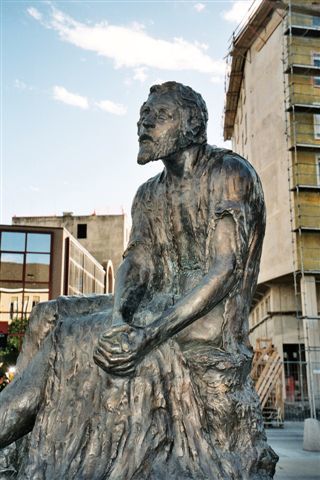 |  1908-1941, 1960 - Servetus Status, place de l'Hôtel de Ville, Annemasse (France).
"It is only at the very beginning of the 20th century that monuments were raised to commemorate Servetus. The Champel memorial was inaugurated in 1903 in the presence of representatives from France. The Geneva memorial being deemed insufficient by the Comite du monument Michel Servet, in 1908, a statue was commissioned, but the Geneva authorities did not authorize its installation. It was then decided to donate the statue to the town of Annemasse, in France, just on the other side of the border [8 km east of Geneva]..... At the request of the Vichy Government, the Annemasse monument was destroyed in 1941. The French resistance later organized a wreath-laying ceremony dedicated to Michel Servet, the first victim of fascism. The monument was finally re-erected in 1960. On the pedestal, an inscription reads: ;The arrest of Servetus in Geneva, where he did neither publish nor dogmatize, hence he was not subject to its laws, has to be considered as a barbaric act and an insult to the Right of Nations.' Voltaire." 1908-1941, 1960 - Servetus Status, place de l'Hôtel de Ville, Annemasse (France).
"It is only at the very beginning of the 20th century that monuments were raised to commemorate Servetus. The Champel memorial was inaugurated in 1903 in the presence of representatives from France. The Geneva memorial being deemed insufficient by the Comite du monument Michel Servet, in 1908, a statue was commissioned, but the Geneva authorities did not authorize its installation. It was then decided to donate the statue to the town of Annemasse, in France, just on the other side of the border [8 km east of Geneva]..... At the request of the Vichy Government, the Annemasse monument was destroyed in 1941. The French resistance later organized a wreath-laying ceremony dedicated to Michel Servet, the first victim of fascism. The monument was finally re-erected in 1960. On the pedestal, an inscription reads: ;The arrest of Servetus in Geneva, where he did neither publish nor dogmatize, hence he was not subject to its laws, has to be considered as a barbaric act and an insult to the Right of Nations.' Voltaire."
|
 |  October 1911 - Servetus Statue, Vienne, Poitou-Charentes (France). "Thanks to an international fund-raising effort, another monument was inaugurated in 1911 in Vienne. An October 22, 1911, New York Times article describes how Americans and 'delegates from every civilized country of the globe' attended the inauguration of yet another statue to commemorate the victim of intolerance." /// NB: Image may be misidentified. October 1911 - Servetus Statue, Vienne, Poitou-Charentes (France). "Thanks to an international fund-raising effort, another monument was inaugurated in 1911 in Vienne. An October 22, 1911, New York Times article describes how Americans and 'delegates from every civilized country of the globe' attended the inauguration of yet another statue to commemorate the victim of intolerance." /// NB: Image may be misidentified.
|
 1905. The Union of Freethinkers for Cremation was founded in 1905, and the Central Union of German Proletariat Freethinker in 1908. The two groups merged in 1927, becoming the German Freethinking Association in 1930. More "bourgeois" organizations declined after World War I, and "proletarian" Freethought groups proliferated, becoming an organization of socialist parties.
1905. The Union of Freethinkers for Cremation was founded in 1905, and the Central Union of German Proletariat Freethinker in 1908. The two groups merged in 1927, becoming the German Freethinking Association in 1930. More "bourgeois" organizations declined after World War I, and "proletarian" Freethought groups proliferated, becoming an organization of socialist parties.

 | S
OC
I
E
T
Y |   1906 - Brooklyn Society for Ethical Culture (BSEC), Brooklyn, New York City, New Youk (USA). "A congregation of individuals & families who choose to emphasize personal growth & social progress as high on their list of priorities. BSEC is a community of communities, attracting good people from all religious traditions, backgrounds, races, family configurations & sexual orientations. We are a liberal religious and educational fellowship without formal creed or dogma. We hold a strong, shared faith in the potential of human beings to develop our compassion, wisdom & ability to work together - to bring about a caring, just & sustainable world." /// Image shows house designed by architect William Tubby as a home for William H. Childs (inventor of Bon Ami Cleaning Powder) which is now occupied by the BSEC. /// "Ethical Societies exist in a score or so of US cities & counties, including Austin, Texas; Baltimore; Boston; Chapel Hill & Asheville, North Carolina; Chicago; Silicon Valley, California; Rittenhouse Square, Philadelphia; St. Louis & St. Peters, Missouri; Washington, DC, and Vienna, Virginia. The largest concentration of Ethical Societies is in the New York metropolitan area, including societies in New York, Manhattan, the Bronx, Brooklyn, Queens, Westchester & Nassau County; & New Jersey, such as Bergen & Essex Counties." 1906 - Brooklyn Society for Ethical Culture (BSEC), Brooklyn, New York City, New Youk (USA). "A congregation of individuals & families who choose to emphasize personal growth & social progress as high on their list of priorities. BSEC is a community of communities, attracting good people from all religious traditions, backgrounds, races, family configurations & sexual orientations. We are a liberal religious and educational fellowship without formal creed or dogma. We hold a strong, shared faith in the potential of human beings to develop our compassion, wisdom & ability to work together - to bring about a caring, just & sustainable world." /// Image shows house designed by architect William Tubby as a home for William H. Childs (inventor of Bon Ami Cleaning Powder) which is now occupied by the BSEC. /// "Ethical Societies exist in a score or so of US cities & counties, including Austin, Texas; Baltimore; Boston; Chapel Hill & Asheville, North Carolina; Chicago; Silicon Valley, California; Rittenhouse Square, Philadelphia; St. Louis & St. Peters, Missouri; Washington, DC, and Vienna, Virginia. The largest concentration of Ethical Societies is in the New York metropolitan area, including societies in New York, Manhattan, the Bronx, Brooklyn, Queens, Westchester & Nassau County; & New Jersey, such as Bergen & Essex Counties."
|
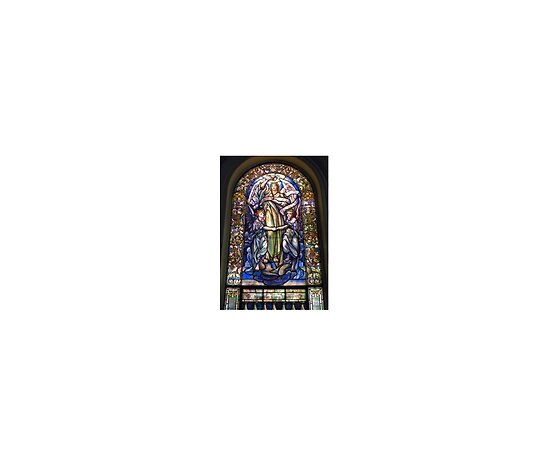  
![]()
|   November 1907 - "Blessed Are The Peacemakers," Arlington Street Church (Unitarian Universalist), Boston, Masssachusetts (USA).
In galleries on the right facing the pulpit. Inscription: "Blessed are the peacemakers for they shall be be called the children of God" [Matthew 5-9]. A memorial to Boston lawyer Alexander Strong Wheeler & presented by his family. "The Tiffany windows in Arlington Street Church are famous for their beauty of design & execution & are believed to be the largest collection of Tiffany windows in any one church. They follow a general plan adopted in 1898 and were installed between 1898 and 1933. The windows represent the highest development of American art in glass. Special Tiffany techniques were used, such as painting certain details & multiple layers of opalescent glass to achieve desired shades of color and Tiffany’s unique creation of folds and drapes.
The windows in the galleries, illustrative of the Beatitudes, were designed by Frederick Wilson [1858-1932]. All of the windows were made under the supervision of Louis Comfort Tiffany [1848-1933] & Edward S. George." November 1907 - "Blessed Are The Peacemakers," Arlington Street Church (Unitarian Universalist), Boston, Masssachusetts (USA).
In galleries on the right facing the pulpit. Inscription: "Blessed are the peacemakers for they shall be be called the children of God" [Matthew 5-9]. A memorial to Boston lawyer Alexander Strong Wheeler & presented by his family. "The Tiffany windows in Arlington Street Church are famous for their beauty of design & execution & are believed to be the largest collection of Tiffany windows in any one church. They follow a general plan adopted in 1898 and were installed between 1898 and 1933. The windows represent the highest development of American art in glass. Special Tiffany techniques were used, such as painting certain details & multiple layers of opalescent glass to achieve desired shades of color and Tiffany’s unique creation of folds and drapes.
The windows in the galleries, illustrative of the Beatitudes, were designed by Frederick Wilson [1858-1932]. All of the windows were made under the supervision of Louis Comfort Tiffany [1848-1933] & Edward S. George."
|
 | S
OC
I
E
T
Y |   1910 - Hall, New York Society for Ethical Culture, 2 West 64th Street (SW corner at Central Park West), New York City, New York (USA). The original ethical society. Founded in 1876 by Felix Adler [1851-1933]. Building has breathtaking views of Central Park and an auditoriam seating 800 people. "The New York Society for Ethical Culture opened its hall on the SW corner of Central Park West & 64th Street in 1911, nine years after it had opened its school building on the NW corner of Central Park West & 63rd Street. The former was designed by Robert D. Kohn and the latter by Robert D. Kohn and Carrère & Hastings. The hall is an imposing but stark, limestone-clad low-rise building in dramatic contrast with the red-brick structure of the school. The two buildings occupy the entire Central Park West blockfront between 63rd & 64th Streets." 1910 - Hall, New York Society for Ethical Culture, 2 West 64th Street (SW corner at Central Park West), New York City, New York (USA). The original ethical society. Founded in 1876 by Felix Adler [1851-1933]. Building has breathtaking views of Central Park and an auditoriam seating 800 people. "The New York Society for Ethical Culture opened its hall on the SW corner of Central Park West & 64th Street in 1911, nine years after it had opened its school building on the NW corner of Central Park West & 63rd Street. The former was designed by Robert D. Kohn and the latter by Robert D. Kohn and Carrère & Hastings. The hall is an imposing but stark, limestone-clad low-rise building in dramatic contrast with the red-brick structure of the school. The two buildings occupy the entire Central Park West blockfront between 63rd & 64th Streets."
|

 | S
TA
T
U
E |   October 28, 1911 - Statue of Robert G. Ingersoll, Glen Oak Park, Peoria, Illinois (USA). From the New York Times: "Oct. 28 -- In the presence of a great crowd a memorial statue of Col. Robert G. Ingersoll [1833-1899], the lecturer & freethinker, one of Peoria's most noted men, was unveiled this afternoon by Robert G. Ingersoll Brown of New York City, a grandson." October 28, 1911 - Statue of Robert G. Ingersoll, Glen Oak Park, Peoria, Illinois (USA). From the New York Times: "Oct. 28 -- In the presence of a great crowd a memorial statue of Col. Robert G. Ingersoll [1833-1899], the lecturer & freethinker, one of Peoria's most noted men, was unveiled this afternoon by Robert G. Ingersoll Brown of New York City, a grandson."
|

 | M
US
E
U
M |   1919 - Sargent House Museum, 49 Middle Street, Gloucester, Massachusetts (USA).
Also known as Sargent-Murray-Gilman-Hough House. "Built in 1782 for writer and activist Judith Sargent Murray [1751-1820], this country's earliest champion of women's equality, education and economic independence, and shared by her husband, Reverend John Murray [1741-1815], the founder of Universalism in America. Then the home of sea merchants, American patriots, religious and community leaders. A fine example of Georgian architecture. Visitors will see Judith Sargent Murray's dictionary and her published series, The Gleaner; and works of art by American painter John Singer Sargent [1856-1925], Judith Sargent Murray's great-great nephew and an original founder of the museum." 1919 - Sargent House Museum, 49 Middle Street, Gloucester, Massachusetts (USA).
Also known as Sargent-Murray-Gilman-Hough House. "Built in 1782 for writer and activist Judith Sargent Murray [1751-1820], this country's earliest champion of women's equality, education and economic independence, and shared by her husband, Reverend John Murray [1741-1815], the founder of Universalism in America. Then the home of sea merchants, American patriots, religious and community leaders. A fine example of Georgian architecture. Visitors will see Judith Sargent Murray's dictionary and her published series, The Gleaner; and works of art by American painter John Singer Sargent [1856-1925], Judith Sargent Murray's great-great nephew and an original founder of the museum."
|
 By 1920 - There are 88 Universalist women ministers, the largest group in the United States.
By 1920 - There are 88 Universalist women ministers, the largest group in the United States.
 | M
US
E
U
M |   1921 - Robert Green Ingersoll Birthplace Museum, Dresden, New York (USA). Closed, then reopened in 1954, closed, then reopened from 1993 to date. Now owned & operated by Center for Free Inquirey (former Council for Secular Humanism) of Amherst, New York. "Historical artifacts, displays, and a specially-produced high-definition video presentation bring Ingersoll and his times to life." Robert Green Ingersoll [1833-1899] was a Civil War veteran, American political leader, and orator during the "Golden Age of Freethought," (late 19th-century USA) noted for his broad range of culture and his defense of agnosticism. 1921 - Robert Green Ingersoll Birthplace Museum, Dresden, New York (USA). Closed, then reopened in 1954, closed, then reopened from 1993 to date. Now owned & operated by Center for Free Inquirey (former Council for Secular Humanism) of Amherst, New York. "Historical artifacts, displays, and a specially-produced high-definition video presentation bring Ingersoll and his times to life." Robert Green Ingersoll [1833-1899] was a Civil War veteran, American political leader, and orator during the "Golden Age of Freethought," (late 19th-century USA) noted for his broad range of culture and his defense of agnosticism.
|
 1925. - European socialist free-thought groups formed the International of Proletarian Freethinkers (IPF) in 1925. Activists agitated for Germans to disaffiliate from the Church and for secularization of elementary schools; between 1919–21 and 1930–32 more than 2.5 million Germans, for the most part supporters of the Social Democratic and Communist parties, gave up church membership. Conflict developed between radical forces including the Soviet League of the Militant Godless and Social Democratic forces in Western Europe led by Theodor Hartwig and Max Sievers. In 1930, the Soviet and allied delegations, following a walk-out, took over the IPF and excluded the former leaders.
1925. - European socialist free-thought groups formed the International of Proletarian Freethinkers (IPF) in 1925. Activists agitated for Germans to disaffiliate from the Church and for secularization of elementary schools; between 1919–21 and 1930–32 more than 2.5 million Germans, for the most part supporters of the Social Democratic and Communist parties, gave up church membership. Conflict developed between radical forces including the Soviet League of the Militant Godless and Social Democratic forces in Western Europe led by Theodor Hartwig and Max Sievers. In 1930, the Soviet and allied delegations, following a walk-out, took over the IPF and excluded the former leaders.
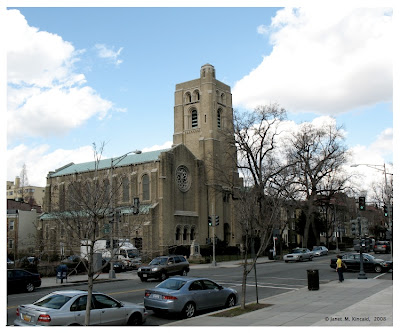 | C
H
UR
C
H |   1925 - "Notwithstanding its tendency toward independence, Universalist congregations supported the construction of the Universalist National Memorial Church, 16th & S Streets, NW, Washington, DC (USA), to serve as the official church of Universalism. In 1921, the Universalist General Convention approved funds for the building of the church, and services began in 1925. The present church, was established in 1930, and its current congregation continues to follow Universalist principles." 1925 - "Notwithstanding its tendency toward independence, Universalist congregations supported the construction of the Universalist National Memorial Church, 16th & S Streets, NW, Washington, DC (USA), to serve as the official church of Universalism. In 1921, the Universalist General Convention approved funds for the building of the church, and services began in 1925. The present church, was established in 1930, and its current congregation continues to follow Universalist principles."
|
 | C
O
UR
T |   July 21, 1925 - Rhea County Courthouse, Dayton, Tennessee (USA. Unintentional monument. "Site of the famous Scopes Monkey Trial, America's biggest news event in 1935. Arguments for & against the teaching of Creation/Evolution in Tennessee public schools were presented by the two most powerful lawyers in the country: Clarance Darrow & William Jennings Bryan. The courthouse still looks much the same now as it did then. Visitors are welcome to go upstairs & see the still active courtroom where the trial took place. There is a small but very intesting museum in the basement of the courthouse." Statue of Bryan stands in front of courthouse. July 21, 1925 - Rhea County Courthouse, Dayton, Tennessee (USA. Unintentional monument. "Site of the famous Scopes Monkey Trial, America's biggest news event in 1935. Arguments for & against the teaching of Creation/Evolution in Tennessee public schools were presented by the two most powerful lawyers in the country: Clarance Darrow & William Jennings Bryan. The courthouse still looks much the same now as it did then. Visitors are welcome to go upstairs & see the still active courtroom where the trial took place. There is a small but very intesting museum in the basement of the courthouse." Statue of Bryan stands in front of courthouse.
|
 1928. - Formation of the General Assembly of Unitarian & Free Christian Churches (GAUFCC), the umbrella organisation for Unitarian, Free Christian & other liberal religious congregations in the United Kingdom. The GAUFCC has several constituent & related traditions - English Presbyterian, General Baptist, Universalist, Methodist, Unitarian & Unitarian Universalist. The GAUFCC was only formed in 1928, but its denominational roots go back to the Great Ejection of 1662, more particularly to the English Presbyterians. The Non-subscribing Presbyterian Church of Ireland maintains very close links with the GAUFCC.
1928. - Formation of the General Assembly of Unitarian & Free Christian Churches (GAUFCC), the umbrella organisation for Unitarian, Free Christian & other liberal religious congregations in the United Kingdom. The GAUFCC has several constituent & related traditions - English Presbyterian, General Baptist, Universalist, Methodist, Unitarian & Unitarian Universalist. The GAUFCC was only formed in 1928, but its denominational roots go back to the Great Ejection of 1662, more particularly to the English Presbyterians. The Non-subscribing Presbyterian Church of Ireland maintains very close links with the GAUFCC.

|  1928 - "The Godless Girl," a drama film directed by Cecil B. DeMille (his last completely silent film). "Features a romance between two different teenagers: a young atheist girl, Judith Craig, and the male head of a Christian youth organization, Bob Hathaway. The two leaders & their groups attack each other, starting a riot that kills a young girl. Followed by a goofy boy, Bozo, the three are thrown into a juvenile prison with a cruel head guard & bad living conditions. The film maker makes a point of talking about the truth of prison cruelty in the middle of the movie.
Bob, who is in love with Judy, eventually rescues her & takes shelter in an old farm where Judy, breathtaken by the romance & beauty of the forest, realizes there must be a God. They are found & taken back to prison & held in solitary confinement until a fire breaks out. Mame is Judy's new friend who is trying to get her out before she burns. But the rest of the prison girls escape. Bob, who is trusting in God to help them, finally rescues Judy with the help of Mame & Bozo; they also rescue the cruel head guard who pleads for his life and, as he is dying, sets them free for their kind act & rescue. At the very end, Bozo and Mame seem to end up together while Bob & Judy & their rekindled faith ride off together as the movie ends." 1928 - "The Godless Girl," a drama film directed by Cecil B. DeMille (his last completely silent film). "Features a romance between two different teenagers: a young atheist girl, Judith Craig, and the male head of a Christian youth organization, Bob Hathaway. The two leaders & their groups attack each other, starting a riot that kills a young girl. Followed by a goofy boy, Bozo, the three are thrown into a juvenile prison with a cruel head guard & bad living conditions. The film maker makes a point of talking about the truth of prison cruelty in the middle of the movie.
Bob, who is in love with Judy, eventually rescues her & takes shelter in an old farm where Judy, breathtaken by the romance & beauty of the forest, realizes there must be a God. They are found & taken back to prison & held in solitary confinement until a fire breaks out. Mame is Judy's new friend who is trying to get her out before she burns. But the rest of the prison girls escape. Bob, who is trusting in God to help them, finally rescues Judy with the help of Mame & Bozo; they also rescue the cruel head guard who pleads for his life and, as he is dying, sets them free for their kind act & rescue. At the very end, Bozo and Mame seem to end up together while Bob & Judy & their rekindled faith ride off together as the movie ends."
|

 1929. - Former Unitarian minister Charles Francis Potter [1885-1962] founds the First Humanist Society of New York. The organization stated as its philosophy a "faith in the supreme value & self-perfectibility of human personality, conceived socially as well as individually." Its advisory board included such notables as Julian Huxley, John Dewey, Albert Einstein & Thomas Mann.
1929. - Former Unitarian minister Charles Francis Potter [1885-1962] founds the First Humanist Society of New York. The organization stated as its philosophy a "faith in the supreme value & self-perfectibility of human personality, conceived socially as well as individually." Its advisory board included such notables as Julian Huxley, John Dewey, Albert Einstein & Thomas Mann.
 After 1933. - Following Hitler's rise to power in 1933, most freethought organizations were banned in Germany, though some right-wing groups that worked with Volkisch associations were tolerated by the Nazis until the mid 1930's.
After 1933. - Following Hitler's rise to power in 1933, most freethought organizations were banned in Germany, though some right-wing groups that worked with Volkisch associations were tolerated by the Nazis until the mid 1930's.
 1935 - Fellowship of Humanity is founded by Reverend A. D. Faupell as one of a handful of "humanist churches" seeded in the early 20th century as part of the American Religious Humanism movement. It is the only such organization to survive into the 21st century and is the first & oldest affiliate of the American Humanist Association (AHA)."
1935 - Fellowship of Humanity is founded by Reverend A. D. Faupell as one of a handful of "humanist churches" seeded in the early 20th century as part of the American Religious Humanism movement. It is the only such organization to survive into the 21st century and is the first & oldest affiliate of the American Humanist Association (AHA)."
1950

| C
HU
R
C
H |   1951 - First Unitarian Society of Madison, Madison, Wisconsin (USA). "The architectural treasure that we call home was designed by Frank Lloyd Wright, a member of the congregation, and was completed in 1951." 1951 - First Unitarian Society of Madison, Madison, Wisconsin (USA). "The architectural treasure that we call home was designed by Frank Lloyd Wright, a member of the congregation, and was completed in 1951."
|
 | C
O
N
F |  1952 - First World Humanist Congress, Amsterdam (Netherlands). "The founding fathers of International Humanist & Ethical Union (IHEU) agreed a statement of the fundamental principles of modern Humanism. They called it 'The Amsterdam Declaration.' That declaration was a child of its time: set in the world of great power politics and the Cold War.
The 50th anniversary World Humanist Congress in 2002, again meeting in the Netherlands, unanimously passed a resolution updating that declaration: 'The Amsterdam Declaration 2002.' Following the Congress, this updated declaration was adopted unanimously by the IHEU General Assembly, and thus became the official defining statement of World Humanism." 1952 - First World Humanist Congress, Amsterdam (Netherlands). "The founding fathers of International Humanist & Ethical Union (IHEU) agreed a statement of the fundamental principles of modern Humanism. They called it 'The Amsterdam Declaration.' That declaration was a child of its time: set in the world of great power politics and the Cold War.
The 50th anniversary World Humanist Congress in 2002, again meeting in the Netherlands, unanimously passed a resolution updating that declaration: 'The Amsterdam Declaration 2002.' Following the Congress, this updated declaration was adopted unanimously by the IHEU General Assembly, and thus became the official defining statement of World Humanism."
|

| T
EA
P
O
T |  1952 - Russell's Teapot. "Sometimes called the Celestial teapot, Cosmic teapot or Bertrand's teapot. An analogy first coined by philosopher Bertrand Russell [1872–1970] to illustrate the idea that the philosophic burden of proof lies upon a person making scientifically unfalsifiable claims rather than shifting the burden of proof to others, specifically in the case of religion. Russell wrote that if he claimed that a teapot were orbiting the sun somewhere in space between the Earth & Mars, it would be nonsensical for him to expect others not to doubt him on the grounds that they could not prove him wrong. Russell's teapot is still referred to in discussions concerning the existence of God & has drawn some criticism for comparing the unfalsifiablility of a teapot to God." 1952 - Russell's Teapot. "Sometimes called the Celestial teapot, Cosmic teapot or Bertrand's teapot. An analogy first coined by philosopher Bertrand Russell [1872–1970] to illustrate the idea that the philosophic burden of proof lies upon a person making scientifically unfalsifiable claims rather than shifting the burden of proof to others, specifically in the case of religion. Russell wrote that if he claimed that a teapot were orbiting the sun somewhere in space between the Earth & Mars, it would be nonsensical for him to expect others not to doubt him on the grounds that they could not prove him wrong. Russell's teapot is still referred to in discussions concerning the existence of God & has drawn some criticism for comparing the unfalsifiablility of a teapot to God."
|

|   1952? - Mark Twain Study, Elmira College, Elmira, New York (USA). Constructed at Quarry Farm in 1874 & moved to current location on campus in 1952. In the 1870's & 1880's, Mark Twain [1835-1910] spent summers in Elmira working on Roughing It, The Adventures of Tom Sawyer, Adventures of Huckleberry Finn, The Prince and the Pauper, A Tramp Abroad, Life on the Mississippi, and A Connecticut Yankee in King Arthur's Court, as well as many short pieces. 1952? - Mark Twain Study, Elmira College, Elmira, New York (USA). Constructed at Quarry Farm in 1874 & moved to current location on campus in 1952. In the 1870's & 1880's, Mark Twain [1835-1910] spent summers in Elmira working on Roughing It, The Adventures of Tom Sawyer, Adventures of Huckleberry Finn, The Prince and the Pauper, A Tramp Abroad, Life on the Mississippi, and A Connecticut Yankee in King Arthur's Court, as well as many short pieces.
|



|   1956-1969 - Peace & Justice Murals, Third Unitarian Church, Mayfield & Fulton Streets, Chicago, Illinois (USA). 24 murals depicting "saints of liberalism." Painted by artist Andrene Kauffman [1905-1993] over a 14 year period. The "saints" (in alphabetical order) are:
Jane Addams,
John Peter Altgeld (governor 1893-1897),
Susan B. Anthony,
E.T. Buehrer (minister 1941-1969),
Albert Camus,
William Ellery Channing,
Confucius,
Ralph Waldo Emerson,
Mohandas Gandhi (left image), Jesus,
Martin Luther King Jr., Thomas Jefferson,
Abraham Lincoln (right image),
James Martineau, Thomas Paine.
Theodore Parker;
Joseph Priestley,
Siddhartha Gautama,
Socrates, Harriet Tubman.
Johann Wolfgang von Goethe,
Walt Whitman,
Roger Williams & Woodrow Wilson. 1956-1969 - Peace & Justice Murals, Third Unitarian Church, Mayfield & Fulton Streets, Chicago, Illinois (USA). 24 murals depicting "saints of liberalism." Painted by artist Andrene Kauffman [1905-1993] over a 14 year period. The "saints" (in alphabetical order) are:
Jane Addams,
John Peter Altgeld (governor 1893-1897),
Susan B. Anthony,
E.T. Buehrer (minister 1941-1969),
Albert Camus,
William Ellery Channing,
Confucius,
Ralph Waldo Emerson,
Mohandas Gandhi (left image), Jesus,
Martin Luther King Jr., Thomas Jefferson,
Abraham Lincoln (right image),
James Martineau, Thomas Paine.
Theodore Parker;
Joseph Priestley,
Siddhartha Gautama,
Socrates, Harriet Tubman.
Johann Wolfgang von Goethe,
Walt Whitman,
Roger Williams & Woodrow Wilson.
|

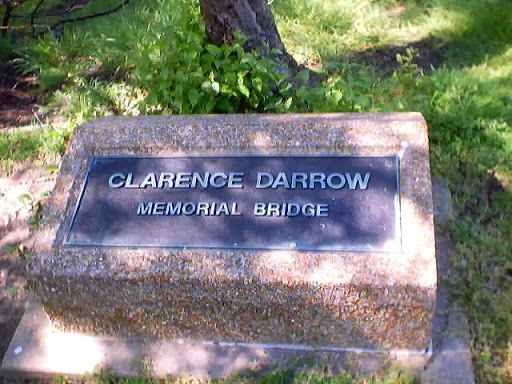

|   1957 - Clarence Darrow Memorial Bridge, Jackson Park Lagoon, near Museum of Science & Industry, Chicago, Illiois (USA). "Clarence Darrow [1857-1938] lived in the Hyde Park neighborhood that includes the museum. He died in Chicago in 1938, and his cremated remains were scattered in the Jackson Park lagoon as he had requested. Every year a wreath-laying ceremony honoring Darrow is held at the bridge spanning the lagoon. In 1957 (the centennial of his birth) the foot bridge was dedicated in his memory." Click here for air photo. 1957 - Clarence Darrow Memorial Bridge, Jackson Park Lagoon, near Museum of Science & Industry, Chicago, Illiois (USA). "Clarence Darrow [1857-1938] lived in the Hyde Park neighborhood that includes the museum. He died in Chicago in 1938, and his cremated remains were scattered in the Jackson Park lagoon as he had requested. Every year a wreath-laying ceremony honoring Darrow is held at the bridge spanning the lagoon. In 1957 (the centennial of his birth) the foot bridge was dedicated in his memory." Click here for air photo.
|

|   1959 - First Unitarian Church, 220 South Winton Road, Rochester, New York (USA). By Estonian-born architect Louis Kahn [1901-1974]. Named as one of the greatest religious structures of the 20th century by Paul Goldberger, Pulitzer Prize-winning architectural critic. Tall, narrow window recesses create an irregular rhythm of shadows on the exterior while four light towers flood the sanctuary walls with indirect natural light. 1959 - First Unitarian Church, 220 South Winton Road, Rochester, New York (USA). By Estonian-born architect Louis Kahn [1901-1974]. Named as one of the greatest religious structures of the 20th century by Paul Goldberger, Pulitzer Prize-winning architectural critic. Tall, narrow window recesses create an irregular rhythm of shadows on the exterior while four light towers flood the sanctuary walls with indirect natural light.
|
1960
 1961 - Unitarian Universalism becomes organized as a religious group with establishment of the Unitarian Universalist Association (UUA), a consolidation of the American Unitarian Association (established in 1825) and the Universalist Church in America (established in 1866). It is headquartered in Boston, Massachusetts, and serves churches mostly in the United States. The Canadian Unitarian Council will become an independent body in 2002.
1961 - Unitarian Universalism becomes organized as a religious group with establishment of the Unitarian Universalist Association (UUA), a consolidation of the American Unitarian Association (established in 1825) and the Universalist Church in America (established in 1866). It is headquartered in Boston, Massachusetts, and serves churches mostly in the United States. The Canadian Unitarian Council will become an independent body in 2002.

|   1962 - Strehly House, Deutschheim State Historic Site, Hermann, Missouri (USA). Constructed in 1842. Acquired later by Carl Procopius Strehly [1810-1875], a Freidenker & "48er" from Germany (or Prague?). He published German-language Licht-Freund & Hermanner Volksblatt with his Eduard Mühl [1800-1854]. His house is now a museum operated by the State of Missouri. "Rosa Strehly lived her entire life in the house [1865-1962], and the rooms remain as they were during her lifetime." Info from page 546 of "The New Encyclopedia of Unbelief" editted by Tom Flynn (2007). 1962 - Strehly House, Deutschheim State Historic Site, Hermann, Missouri (USA). Constructed in 1842. Acquired later by Carl Procopius Strehly [1810-1875], a Freidenker & "48er" from Germany (or Prague?). He published German-language Licht-Freund & Hermanner Volksblatt with his Eduard Mühl [1800-1854]. His house is now a museum operated by the State of Missouri. "Rosa Strehly lived her entire life in the house [1865-1962], and the rooms remain as they were during her lifetime." Info from page 546 of "The New Encyclopedia of Unbelief" editted by Tom Flynn (2007).
|
  

|   1960's - Humanist Center, 105 North College Street, Yellow Springs, Ohio (USA). "This was the headquarters of the American Humanist Association (AHA) in the 1960's! The building still exists, & it is still called the 'Humanist Center!'" It now houses health & legal professional offices. AHA headquarters are now in Washington, DC. 1960's - Humanist Center, 105 North College Street, Yellow Springs, Ohio (USA). "This was the headquarters of the American Humanist Association (AHA) in the 1960's! The building still exists, & it is still called the 'Humanist Center!'" It now houses health & legal professional offices. AHA headquarters are now in Washington, DC.
|
1970
 | G
RA
V
E |   After 1970 -
Grave of Bertrand Russell, Trinity College, Cambridge (England). Latin inscription translates in part: "(He) was famous as a writer and expositor of the philosophy in particular of mathematics. Having long been vexed with the folly of his fellow men, as an old man he threw himself with youthful ardour wholeheartedly into the cause of maintianing peace among the nations; at length, loaded with many honours and renowned throughout the world, he rested from his efforts at the age of ninety-seven." After 1970 -
Grave of Bertrand Russell, Trinity College, Cambridge (England). Latin inscription translates in part: "(He) was famous as a writer and expositor of the philosophy in particular of mathematics. Having long been vexed with the folly of his fellow men, as an old man he threw himself with youthful ardour wholeheartedly into the cause of maintianing peace among the nations; at length, loaded with many honours and renowned throughout the world, he rested from his efforts at the age of ninety-seven."
|
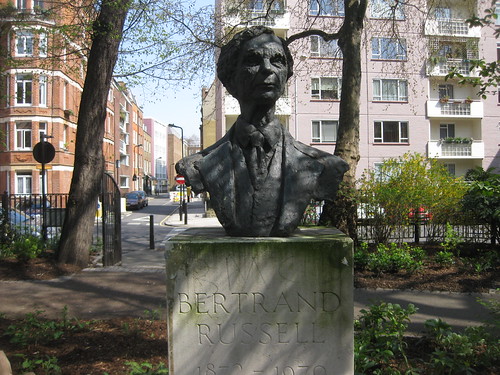
 | B
US
T |   1980 - Bust of Bertrand Russell, Red Lion Square, London WC1 (England). Sculpted by Marcelle Quinton. Bertrand Russell [1872-1970] received the 1950 Nobel Prize for Literature. One of 21 peace monuments named by the PPU website. Named in "A Peace Trail Through London" by Valerie Flessati (1998). One of 309 London monuments in Kershman (2007), page 196. 1980 - Bust of Bertrand Russell, Red Lion Square, London WC1 (England). Sculpted by Marcelle Quinton. Bertrand Russell [1872-1970] received the 1950 Nobel Prize for Literature. One of 21 peace monuments named by the PPU website. Named in "A Peace Trail Through London" by Valerie Flessati (1998). One of 309 London monuments in Kershman (2007), page 196.
|  | P
LA
Q
U
E |   2002 - Blue Plaque for Bertrand Russell, 34 Russell Chambers, Bury Place, London WC1 (England). Russell lived here in flat no.34, 1911-1916. 2002 - Blue Plaque for Bertrand Russell, 34 Russell Chambers, Bury Place, London WC1 (England). Russell lived here in flat no.34, 1911-1916.
|

|   1973 - Omega Peace Institute (OPI), Arkansas Avenue, North Mesa, Los Alamos New Mexico (USA). Next door to Black Hole (qv). Former Grace Lutheran Church purchased in 1973 by Ed Grothus [1923-2009]. First called 'The Omega Peace Institute' and later named 'The First Church of High Technology.' "Adorned with a large peace sign mounted on the [A-frame] building, two symbolically broken torpedos out front, and a sign that reads: "OMEGA PEACE INSTITUTE, FIRST CHURCH OF HIGH TECHNOLOGY, BLACK HOLE SYNOD, Critical Mass Every Sunday with Bomb Unworship Service.' Actually, no services are held, and the church building itself is stuffed with more junk [from the Black Hole]." 1973 - Omega Peace Institute (OPI), Arkansas Avenue, North Mesa, Los Alamos New Mexico (USA). Next door to Black Hole (qv). Former Grace Lutheran Church purchased in 1973 by Ed Grothus [1923-2009]. First called 'The Omega Peace Institute' and later named 'The First Church of High Technology.' "Adorned with a large peace sign mounted on the [A-frame] building, two symbolically broken torpedos out front, and a sign that reads: "OMEGA PEACE INSTITUTE, FIRST CHURCH OF HIGH TECHNOLOGY, BLACK HOLE SYNOD, Critical Mass Every Sunday with Bomb Unworship Service.' Actually, no services are held, and the church building itself is stuffed with more junk [from the Black Hole]."
|

|   1973 - Church of Humanism, New York City, New York(USA). All meetings held at Fourth Universalist Society, 4 West 76 Street, New York City. Founded by Rev. Joseph Ben-David "in the Humanist spirit of Dr. Norbert F. Capek & other great minds such as Martin Buber, Erich Fromm, Julian Huxley, Bertrand Russell, Felix Adler, Abraham Maslow & Albert Schweitzer." 1973 - Church of Humanism, New York City, New York(USA). All meetings held at Fourth Universalist Society, 4 West 76 Street, New York City. Founded by Rev. Joseph Ben-David "in the Humanist spirit of Dr. Norbert F. Capek & other great minds such as Martin Buber, Erich Fromm, Julian Huxley, Bertrand Russell, Felix Adler, Abraham Maslow & Albert Schweitzer."
|
1980
![]()
| I
NS
T |   August 1982 - Humanist Institute, (USA). "Forty-five humanist leaders gathered at the University of Chicago to form the North American Committee for Humanism. This new alliance was a response to the urgent need to defend humanism against the assaults of its adversaries & to find an effective way to bring the message of humanism to a wider public. At this meeting, the committee voted to establish the The Humanist Institute. Since that time, 14 classes have graduated from the program, providing over a 100 skilled leaders to the humanist community & the larger world." August 1982 - Humanist Institute, (USA). "Forty-five humanist leaders gathered at the University of Chicago to form the North American Committee for Humanism. This new alliance was a response to the urgent need to defend humanism against the assaults of its adversaries & to find an effective way to bring the message of humanism to a wider public. At this meeting, the committee voted to establish the The Humanist Institute. Since that time, 14 classes have graduated from the program, providing over a 100 skilled leaders to the humanist community & the larger world."
|
1990
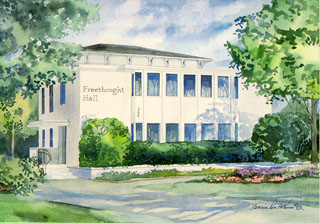 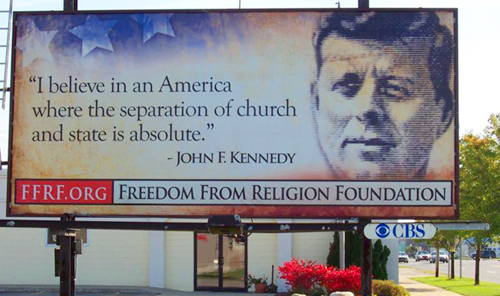

| O
FF
I
C
E |   1990 - Freethought Hall, Madison, Wisconsin (USA). National office of the Freedom From Religion Foundation (FFRF). Purchased in 1990.One of the oldest buildings in downtown Madison, it houses the Blanche Fearn reception room & Elizabeth Elliott library of more than 2,000 freethought books.
The sandstone structure was built as a family home in 1855. The building became a church rectory for 20 years in the late 1880's. /// "Incorporated in 1978 in Wisconsin, the Foundation is a national membership association of freethinkers: Atheists, agnostics & skeptics of any pedigree." 1990 - Freethought Hall, Madison, Wisconsin (USA). National office of the Freedom From Religion Foundation (FFRF). Purchased in 1990.One of the oldest buildings in downtown Madison, it houses the Blanche Fearn reception room & Elizabeth Elliott library of more than 2,000 freethought books.
The sandstone structure was built as a family home in 1855. The building became a church rectory for 20 years in the late 1880's. /// "Incorporated in 1978 in Wisconsin, the Foundation is a national membership association of freethinkers: Atheists, agnostics & skeptics of any pedigree."
|
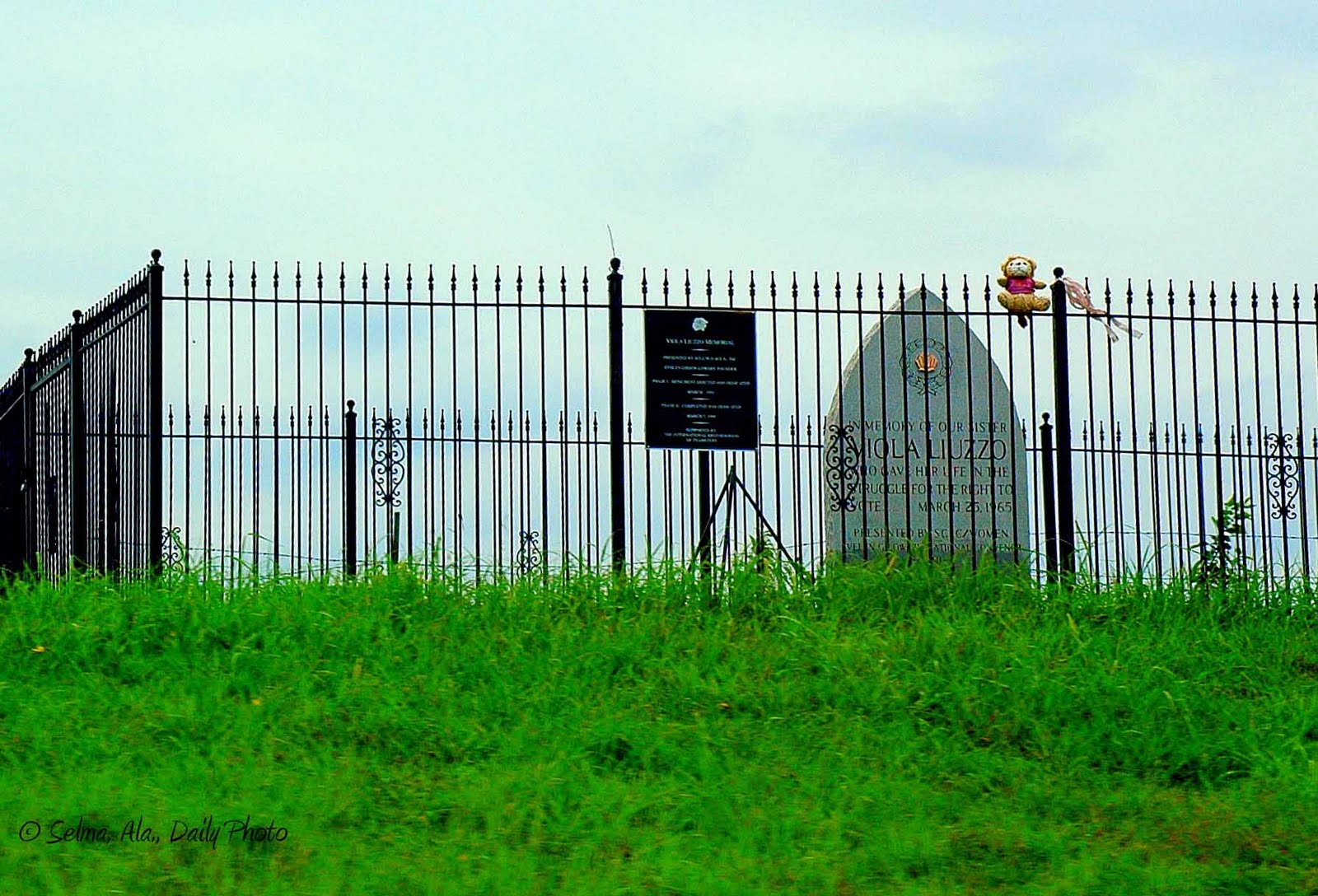 |   1991 - Monument to Viola Gregg Liuzzo [1925-1965], highway between Selma & Montgomery, Alabama (USA). "This brave [Unitarian] civil rights heroine of Detroit, Michigan, was killed by Ku Klux Klansmen, [two days] after the Selma-Montgomery March in 1965. Since Mrs. [Evelyn G.] Lowery established and dedicated this monument in 1991, it has been defaced and vandalized many times. But it still stands strong and tall as a testimony to the promise that 'We Shall Overcome!'" Monument is isolated on side of the highway where the murder took place. A fence has been constructed to protect it from further vandalism. 1991 - Monument to Viola Gregg Liuzzo [1925-1965], highway between Selma & Montgomery, Alabama (USA). "This brave [Unitarian] civil rights heroine of Detroit, Michigan, was killed by Ku Klux Klansmen, [two days] after the Selma-Montgomery March in 1965. Since Mrs. [Evelyn G.] Lowery established and dedicated this monument in 1991, it has been defaced and vandalized many times. But it still stands strong and tall as a testimony to the promise that 'We Shall Overcome!'" Monument is isolated on side of the highway where the murder took place. A fence has been constructed to protect it from further vandalism.
|
 | P
LA
Q
U
E |  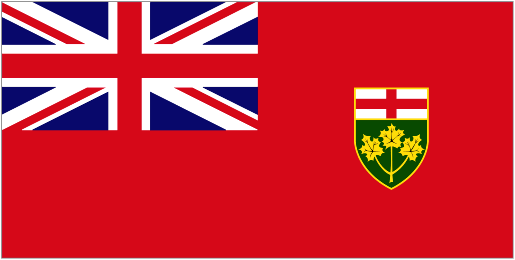 1992 - Plaque entitled "Sri Chinmoy International Peace Falls," Niagara Falls, Ontario (Canada). Sri Chinmoy [1931-2007] "was an Indian spiritual teacher and philosopher who emigrated to the USA in 1964. An author, composer, artist, and athlete, he was perhaps best known for holding public events on the theme of inner peace and world harmony (such as concerts, meditations, and races)... In 1996, a plaque associated with Sri Chinmoy at the Statue of Liberty [New York City, NY (USA)] was removed by the National Park Service after several weeks of protests due to a call by American Atheists, who viewed this as a violation of the separation of church and state." Image & information courtesy of Ed Buckner, president of American Atheists. 1992 - Plaque entitled "Sri Chinmoy International Peace Falls," Niagara Falls, Ontario (Canada). Sri Chinmoy [1931-2007] "was an Indian spiritual teacher and philosopher who emigrated to the USA in 1964. An author, composer, artist, and athlete, he was perhaps best known for holding public events on the theme of inner peace and world harmony (such as concerts, meditations, and races)... In 1996, a plaque associated with Sri Chinmoy at the Statue of Liberty [New York City, NY (USA)] was removed by the National Park Service after several weeks of protests due to a call by American Atheists, who viewed this as a violation of the separation of church and state." Image & information courtesy of Ed Buckner, president of American Atheists. 
|

|   After September 29, 1995 - Unmarked Grave of Madalyn Murray O'Hair, private family residence, near Austin, Texas (USA). Madalyn Murray O'Hair [1919-1995] was an American atheist activist, founder of the organization American Atheists & its president 1963-1986. One of her sons, Jon Garth Murray [1954-1995], was president 1986-1995.
She is best known for the Murray v. Curlett lawsuit, which led to a landmark Supreme Court ruling [in 1963] ending government-sponsored prayer in American public schools. American Atheists became so controversial by 1964 that Life magazine referred to her as 'the most hated woman in America.' In 1995, she was kidnapped & murdered, along with her son Jon & granddaughter by a member of the organization, David Roland Waters." Image shows O'Hair in 1983 in front of the Robert Ingersoll statue (qv) in Glen Oak Park, Peoria, Illinois. After September 29, 1995 - Unmarked Grave of Madalyn Murray O'Hair, private family residence, near Austin, Texas (USA). Madalyn Murray O'Hair [1919-1995] was an American atheist activist, founder of the organization American Atheists & its president 1963-1986. One of her sons, Jon Garth Murray [1954-1995], was president 1986-1995.
She is best known for the Murray v. Curlett lawsuit, which led to a landmark Supreme Court ruling [in 1963] ending government-sponsored prayer in American public schools. American Atheists became so controversial by 1964 that Life magazine referred to her as 'the most hated woman in America.' In 1995, she was kidnapped & murdered, along with her son Jon & granddaughter by a member of the organization, David Roland Waters." Image shows O'Hair in 1983 in front of the Robert Ingersoll statue (qv) in Glen Oak Park, Peoria, Illinois.
|
 


|   August 1998 - Freidenker Memorial, Comfort, Hill Country, Texas (USA). Next door to the the Ingenhuett General Store.
"A 15-foot stone monument or cenotaph acknowledging the [German] freidenkers [freethinkers] as Comfort's founders was installed in the town park... [But] Christian fundamentalists forced the town's chamber of commerce & its heritage foundation to reverse their prvious support. The cenotaph was removed [on December 21, 2000] & dumped a few miles outside Comfort. [On November 2, 2002] it was installed on private propety in the town's historic district." A new plaque is headed "Die Gedanken sind frei / Thoughts are free." ("Established in 1867, the Ingenhuett General Store was the longest continually operated general store in Texas. It was Comfort's historical center & gathering place for more than a century [until] it burned down in 2006.…") Info from page 546 of "The New Encyclopedia of Unbelief" editted by Tom Flynn (2007). August 1998 - Freidenker Memorial, Comfort, Hill Country, Texas (USA). Next door to the the Ingenhuett General Store.
"A 15-foot stone monument or cenotaph acknowledging the [German] freidenkers [freethinkers] as Comfort's founders was installed in the town park... [But] Christian fundamentalists forced the town's chamber of commerce & its heritage foundation to reverse their prvious support. The cenotaph was removed [on December 21, 2000] & dumped a few miles outside Comfort. [On November 2, 2002] it was installed on private propety in the town's historic district." A new plaque is headed "Die Gedanken sind frei / Thoughts are free." ("Established in 1867, the Ingenhuett General Store was the longest continually operated general store in Texas. It was Comfort's historical center & gathering place for more than a century [until] it burned down in 2006.…") Info from page 546 of "The New Encyclopedia of Unbelief" editted by Tom Flynn (2007).
|




|   July 4, 1999 - Atheists in Foxholes Monument, Freedom From Religion Foundation (FFRF), Freethought Hall, Lake Hypatia Munford, Alabama (USA). Inscribed: "In memory of ATHEISTS IN FOXHOLES and the countless FREETHINKERS [atheists, agnostics & skeptics of any persuasion] who have served this country with honor and distinction. Presented by the national FFRF with hope that in the future humankind may learn to avoid all war." The FFRF originally proposed an "Atheists in Foxholes" monument to replace a cross on public property in San Diego, California, but the foundation's formal bid was rejected in favor of religious bidders. /// Lake Hypatia is named for Hypatia [d. March 415], "a Greek scholar from Alexandria (Egypt) considered to be the first notable female mathematician. She was asassinated by a Christian mob who accused her of causing religious turmoil." July 4, 1999 - Atheists in Foxholes Monument, Freedom From Religion Foundation (FFRF), Freethought Hall, Lake Hypatia Munford, Alabama (USA). Inscribed: "In memory of ATHEISTS IN FOXHOLES and the countless FREETHINKERS [atheists, agnostics & skeptics of any persuasion] who have served this country with honor and distinction. Presented by the national FFRF with hope that in the future humankind may learn to avoid all war." The FFRF originally proposed an "Atheists in Foxholes" monument to replace a cross on public property in San Diego, California, but the foundation's formal bid was rejected in favor of religious bidders. /// Lake Hypatia is named for Hypatia [d. March 415], "a Greek scholar from Alexandria (Egypt) considered to be the first notable female mathematician. She was asassinated by a Christian mob who accused her of causing religious turmoil."
|
Fearn Park is named for Blanche Fearn (1911-1995) who was a major supporter of the original hall after Melody, Roger and Pat donated property to FFRF for the purpose of building a Freethought Hall. Ms. Fearn was born in the South Bronx, NY, and was a public school teacher, author, and freethought activist. The original hall was opened in 1991 and was filled to overflow during the Fourth of July 1991. Expansion was needed, but the money wasn't there. In 1998, a memorial for Edyth Aryant Rizzo in the amount of $500.00 was given. Roger and Pat Cleveland matched the amount. The expansion was approved and a national fund-raiser was approved. Roger had the faith.
Dr. George Whatley gave a very generous donation that meant we were on our way. Dr. Whatley, a retired physician and a great Alabama freethinker allowed us to name the auditorium for his late wife, Willa Mae Whatley. The auditorium was built under the guidance of Roger Cleveland. Fearn Park has a large concrete five pointed star built by Bill Teague, a WWII vet. The star is to honor modern women of freethought. The names from Alabama are: Ileen Sparks, Rachel Doughty, Michelle Wilson, Eula McGill (National Labor Organizer from the thirties through her retirement in 1982), and Pat Cleveland. Annie Laurie Gaylor and Anne Gaylor from Wisconsin have their names there. The famous Texas atheist, Catherine Fahringer, is included. The names of Blanche Fearn and Dot Drake complete the freethought star tribute.
The "Atheists-in-Foxholes" monument is adjacent to the Willa Mae Whatley Auditorium in Fearn Park, overlooking Lake Hypatia. After all the decisions about how it was to be shaped and what was to be on it, Bill Teague volunteered to coordinate the monument project. After all the preparation of the design, Bill had the monument cut, the foundation laid, and the monument placed on the foundation. On one side is the emblem of the US Air Force and the US Army, on another is the emblem of the US Navy and the US Marine Corps, on another the emblem of the US Coast Guard and the US Merchant Marine. On the front of the monument is:
IN MEMORY OF ATHEISTS IN FOXHOLES AND COUNTLESS FREETHINKERS WHO HAVE SERVED THIS COUNTRY WITH HONOR AND DISTINCTION PRESENTED BY THE NATIONAL FREEDOM FROM RELIGION FOUNDATION WITH HOPE THAT IN THE FUTURE MANKIND MAY LEARN TO AVOID ALL WAR
Willa Mae Whatley Auditorium, Fearn Park and the "Atheists-in-Foxholes" monument were all dedicated on July 4, 1999, during the annual Freethought Homecoming.
2000

| F
SM |   May 2005 - Flying Spaghetti Monster (FSM). "The deity of the parody religion Church of the Flying Spaghetti Monster (aka Pastafarianism). First appeared in a satirical open letter by Bobby Henderson in 2005, written in protest against the decision by the Kansas State Board of Education to permit the teaching of intelligent design as an alternative to evolution in public school science classes. The letter parodied the concept of intelligent design by professing belief in a supernatural creator that closely resembles spaghetti & meatballs. Henderson further called for Flying Spaghetti Monsterism to be allotted equal time in science classrooms alongside intelligent design & evolution." May 2005 - Flying Spaghetti Monster (FSM). "The deity of the parody religion Church of the Flying Spaghetti Monster (aka Pastafarianism). First appeared in a satirical open letter by Bobby Henderson in 2005, written in protest against the decision by the Kansas State Board of Education to permit the teaching of intelligent design as an alternative to evolution in public school science classes. The letter parodied the concept of intelligent design by professing belief in a supernatural creator that closely resembles spaghetti & meatballs. Henderson further called for Flying Spaghetti Monsterism to be allotted equal time in science classrooms alongside intelligent design & evolution."
|

|   March 2008, Flying Spaghetti Monster (FSM), Courthouse Lawn, Crossville, Tennessee (USA). Pastafarians Ariel & David Sufdie placed the statue in a free speech zone. It gained national interest on blogs and internet news sites and appeared in Rolling Stone magazine. It was later removed from the premises, along with all other long-term statues, due to an effort sparked mainly by controversy over the statue." March 2008, Flying Spaghetti Monster (FSM), Courthouse Lawn, Crossville, Tennessee (USA). Pastafarians Ariel & David Sufdie placed the statue in a free speech zone. It gained national interest on blogs and internet news sites and appeared in Rolling Stone magazine. It was later removed from the premises, along with all other long-term statues, due to an effort sparked mainly by controversy over the statue."
|



| T
RA
I
L |   2005 -
Freethought Trail, Council for Secular Humanism, Amherst, New York (USA). "A collection of locations in west-central New York State important to the history of freethought. In the 19th century, [this area] was a hotbed of social, political & religious innovation. Fayetteville suffragist Matilda Joslyn Gage [1826-1898] called religion the enemy of women. Writing from Elmira, Mark Twain [1835-1910] raised irreverence to an American art form. At Ithaca, Andrew Dickson White [1832-1918] co-founded Cornell University, the nation's first secular institution of higher learning. In 1848 reformers & freethinkers thronged Seneca Falls to demand new roles for women. Corning native Margaret Sanger [1879-1966] led the birth control movement. The birthplace museum of orator, political speechmaker & outspoken agnostic Robert G. Ingersoll [1833-1899] is in Dresden." The trail was wholly redesigned and expanded in 2009. 2005 -
Freethought Trail, Council for Secular Humanism, Amherst, New York (USA). "A collection of locations in west-central New York State important to the history of freethought. In the 19th century, [this area] was a hotbed of social, political & religious innovation. Fayetteville suffragist Matilda Joslyn Gage [1826-1898] called religion the enemy of women. Writing from Elmira, Mark Twain [1835-1910] raised irreverence to an American art form. At Ithaca, Andrew Dickson White [1832-1918] co-founded Cornell University, the nation's first secular institution of higher learning. In 1848 reformers & freethinkers thronged Seneca Falls to demand new roles for women. Corning native Margaret Sanger [1879-1966] led the birth control movement. The birthplace museum of orator, political speechmaker & outspoken agnostic Robert G. Ingersoll [1833-1899] is in Dresden." The trail was wholly redesigned and expanded in 2009.
|



|   July 18, 2005 - Ten Comandments, Barrow County Court House, Winder, Georgia (USA). "US District Court Judge William O’Kelley signed a Consent Order, which was proposed jointly by Barrow County & the American Civil Liberties Union (ACLU) of Georgia, that requires Barrow County to immediately remove the Ten Commandments display currently hanging in the Barrow County Courthouse.
'Now all citizens of Barrow County, regardless of their religious beliefs, can feel welcome in their own community. They will no longer feel like outsiders in their own courthouse,' said Maggie Garrett, Staff Attorney with the ACLU of Georgia.
In addition to having to remove the display, the County will be prohibited from posting similar displays in the future & must reimburse the ACLU $150,000 in attorneys’ fees & expenses.
The ACLU filed the case on behalf of 'John Doe,' who wants his identity protected because he fears reprisals. John Doe will remain anonymous under the Order." July 18, 2005 - Ten Comandments, Barrow County Court House, Winder, Georgia (USA). "US District Court Judge William O’Kelley signed a Consent Order, which was proposed jointly by Barrow County & the American Civil Liberties Union (ACLU) of Georgia, that requires Barrow County to immediately remove the Ten Commandments display currently hanging in the Barrow County Courthouse.
'Now all citizens of Barrow County, regardless of their religious beliefs, can feel welcome in their own community. They will no longer feel like outsiders in their own courthouse,' said Maggie Garrett, Staff Attorney with the ACLU of Georgia.
In addition to having to remove the display, the County will be prohibited from posting similar displays in the future & must reimburse the ACLU $150,000 in attorneys’ fees & expenses.
The ACLU filed the case on behalf of 'John Doe,' who wants his identity protected because he fears reprisals. John Doe will remain anonymous under the Order."
|



| P
LA
Q
U
E | 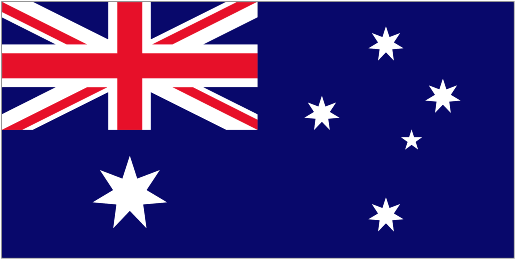 September 5, 2006 - Plaque honoring Charles Darwin, Charles Darwin Park, Wallerawang, near Lithgow, New South Wales (Australia). At site of the house where Darwin (age 26) stayed January 12-30, 1836. Note platypus descending the stone. September 5, 2006 - Plaque honoring Charles Darwin, Charles Darwin Park, Wallerawang, near Lithgow, New South Wales (Australia). At site of the house where Darwin (age 26) stayed January 12-30, 1836. Note platypus descending the stone.
|

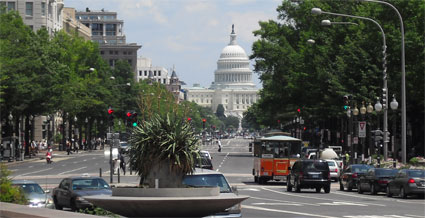

| T
R
A
I
L  2009 -
Robert G. Ingersoll Washington, D.C., Walking Tour, Washington Area Secular Humanists (WASH), Washington, DC (USA).
Eleven tour stops related to famous orator, political speechmaker & outspoken agnostic Robert G. Ingersoll [1833-1899]. Original tour Gary C. Grassl, Silver Hill, Maryland. Second Edition updated & digitized in 2009
by Steven C. Lowe, Washington, DC.s legacy can be preserved and advanced by a 21st century research and education laboratory committed to enhancing our understanding of life in the universe and furthering the cause of space exploration for all time", said NASA Administrator Daniel Goldin. Ann Druyan was at the Center as it opened its doors on October 22, 2006." 2009 -
Robert G. Ingersoll Washington, D.C., Walking Tour, Washington Area Secular Humanists (WASH), Washington, DC (USA).
Eleven tour stops related to famous orator, political speechmaker & outspoken agnostic Robert G. Ingersoll [1833-1899]. Original tour Gary C. Grassl, Silver Hill, Maryland. Second Edition updated & digitized in 2009
by Steven C. Lowe, Washington, DC.s legacy can be preserved and advanced by a 21st century research and education laboratory committed to enhancing our understanding of life in the universe and furthering the cause of space exploration for all time", said NASA Administrator Daniel Goldin. Ann Druyan was at the Center as it opened its doors on October 22, 2006."
| |
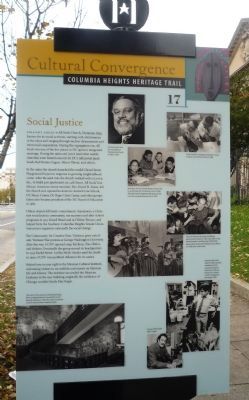

|   2009, "Cultural Convergence" Marker, Columbia Heights Heritage Trail, 16th Street, NW (south of Harvard Street), Washington, DC (USA).
Inscribed "Straight ahead is All Souls Church, Unitarian, long known for its social activism, starting with abolitionism in the 1820s and ranging through nuclear disarmament and interracial cooperation. During the segregation era, All Souls was one of the few places in DC open to integrated meetings. During the 1980's and '90s it (and other neighborhood churches) even hosted concerts by DC's influential punk bands Bad Brains, Fugazi, Minor Threat, and others. In the 1960's, the church launched the model Girard Street Playground Project in response to growing neighborhood crime. After the 1968 riots, the church worked with Change, Inc. to build 406 apartments on 14th Street. All Souls' first African American senior minister, Rev. David H. Eaton led the church as it opened its doors to Antioch Law School, DC Music Center, DC Rape Crisis Center, and other groups. Eaton also became president of the DC Board of Education in 1982..." 2009, "Cultural Convergence" Marker, Columbia Heights Heritage Trail, 16th Street, NW (south of Harvard Street), Washington, DC (USA).
Inscribed "Straight ahead is All Souls Church, Unitarian, long known for its social activism, starting with abolitionism in the 1820s and ranging through nuclear disarmament and interracial cooperation. During the segregation era, All Souls was one of the few places in DC open to integrated meetings. During the 1980's and '90s it (and other neighborhood churches) even hosted concerts by DC's influential punk bands Bad Brains, Fugazi, Minor Threat, and others. In the 1960's, the church launched the model Girard Street Playground Project in response to growing neighborhood crime. After the 1968 riots, the church worked with Change, Inc. to build 406 apartments on 14th Street. All Souls' first African American senior minister, Rev. David H. Eaton led the church as it opened its doors to Antioch Law School, DC Music Center, DC Rape Crisis Center, and other groups. Eaton also became president of the DC Board of Education in 1982..."
|

|   October 28, 2009, "Keep Religion OUT of Government" billboard, 2600 block of North Avenue, Grand Junction, Colorado (USA). "The Freedom From Religion Foundation (FFRF) today announced it is offering a $1,000 award to anyone coming forward with information leading to the arrest and conviction of the perpetrator(s) of a hate crime directed against the Foundation and gays. The Foundation's billboard was defaced, apparently last weekend. A vandal X'ed out the word "religion," and painted in the word "fag." "This is a hate crime directed both at the nonreligious and at gays—it's a perversion of our message honoring a precious constitutional principle," said Foundation Co-President, Annie Laurie Gaylor." October 28, 2009, "Keep Religion OUT of Government" billboard, 2600 block of North Avenue, Grand Junction, Colorado (USA). "The Freedom From Religion Foundation (FFRF) today announced it is offering a $1,000 award to anyone coming forward with information leading to the arrest and conviction of the perpetrator(s) of a hate crime directed against the Foundation and gays. The Foundation's billboard was defaced, apparently last weekend. A vandal X'ed out the word "religion," and painted in the word "fag." "This is a hate crime directed both at the nonreligious and at gays—it's a perversion of our message honoring a precious constitutional principle," said Foundation Co-President, Annie Laurie Gaylor."
|
2010

|   Christmas 2010, Atheist billboard, west end of Lincoln Tunnel, North Bergen, New Jersey (USA). Christmas 2010, Atheist billboard, west end of Lincoln Tunnel, North Bergen, New Jersey (USA).
|

|   Christmas 2010, Christian billboard, Manhattan, New York (USA). "Days after an atheist group posted a billboard mocking the Christmas holiday at the New Jersey approach to the Lincoln Tunnel, a Catholic organization has responded with its own message on the New York side.
'You know it’s real,' the newer billboard tells drivers passing the corner of Dyer Avenue & West 31st Street in Manhattan. 'This season, celebrate Jesus.'
The sign, sponsored by the New York-based Catholic League for Religious & Civil Rights, mimics the wording and design of a 14-by-48 foot billboard erected by an atheist group along Route 495 in North Bergen on Nov. 22." Christmas 2010, Christian billboard, Manhattan, New York (USA). "Days after an atheist group posted a billboard mocking the Christmas holiday at the New Jersey approach to the Lincoln Tunnel, a Catholic organization has responded with its own message on the New York side.
'You know it’s real,' the newer billboard tells drivers passing the corner of Dyer Avenue & West 31st Street in Manhattan. 'This season, celebrate Jesus.'
The sign, sponsored by the New York-based Catholic League for Religious & Civil Rights, mimics the wording and design of a 14-by-48 foot billboard erected by an atheist group along Route 495 in North Bergen on Nov. 22."
|

|   Christmas 2011, Atheist billboard, west end of Lincoln Tunnel, North Bergen, New Jersey (USA). "For a second year in a row, American Atheists is posting seasonal billboards. One of the billboards is located on the New Jersey side just before entering the Lincoln Tunnel into Manhattan. The Lincoln Tunnel carries almost 120,000 vehicles per day, making it one of the busiest vehicular tunnels in the world and a prime location for a billboard.
The controversial billboard is the next stage of the "You KNOW it's a MYTH" campaign, which began last year." Christmas 2011, Atheist billboard, west end of Lincoln Tunnel, North Bergen, New Jersey (USA). "For a second year in a row, American Atheists is posting seasonal billboards. One of the billboards is located on the New Jersey side just before entering the Lincoln Tunnel into Manhattan. The Lincoln Tunnel carries almost 120,000 vehicles per day, making it one of the busiest vehicular tunnels in the world and a prime location for a billboard.
The controversial billboard is the next stage of the "You KNOW it's a MYTH" campaign, which began last year."
|

|   March 24, 2012 - Reason Rally, National Mall, Washington, DC (USA). Slogan: "The largest gathering of the secular movement in world history." /// "A rally for secularism & religious skepticism. Sponsored by major atheistic & secular organizations. Regarded as a 'Woodstock for atheists & skeptics.'
Speakers & performers included biologist Richard Dawkins, musician Tim Minchin, MythBusters co-host Adam Savage, actor-comedian Eddie Izzard, Paul Provenza, PZ Myers, Jessica Ahlquist, Dan Barker, and magician James Randi, among others. The punk rock band Bad Religion performed and other notables (Rep. Pete Stark, Sen. Tom Harkin, comedian Bill Maher, magician Penn Jillette) addressed the crowd by video link. Participants recited the Pledge of Allegiance, deliberately omitting the phrase "under God", which was added by the US Congress in 1954. Veterans of the US Armed Forces were represented, and a retired Army colonel, Kirk Lamb, led veterans in an affirmation of their secular military oaths. Speakers urged those assembled to contact local and national representatives and ask them to support church-state separation, science education, marriage equality for gays and lesbians, and ending government support of faith-based organizations, among other causes." March 24, 2012 - Reason Rally, National Mall, Washington, DC (USA). Slogan: "The largest gathering of the secular movement in world history." /// "A rally for secularism & religious skepticism. Sponsored by major atheistic & secular organizations. Regarded as a 'Woodstock for atheists & skeptics.'
Speakers & performers included biologist Richard Dawkins, musician Tim Minchin, MythBusters co-host Adam Savage, actor-comedian Eddie Izzard, Paul Provenza, PZ Myers, Jessica Ahlquist, Dan Barker, and magician James Randi, among others. The punk rock band Bad Religion performed and other notables (Rep. Pete Stark, Sen. Tom Harkin, comedian Bill Maher, magician Penn Jillette) addressed the crowd by video link. Participants recited the Pledge of Allegiance, deliberately omitting the phrase "under God", which was added by the US Congress in 1954. Veterans of the US Armed Forces were represented, and a retired Army colonel, Kirk Lamb, led veterans in an affirmation of their secular military oaths. Speakers urged those assembled to contact local and national representatives and ask them to support church-state separation, science education, marriage equality for gays and lesbians, and ending government support of faith-based organizations, among other causes."
|

 March 25-26, 2012 - Annual Convention of American Atheists, Bethesda North Marriott & Convention Center, Bethesda, Maryland (USA). "This year's theme: 'Come out! Come out! Wherever you Are!' We will be concentrating this packed-to-the gills convention with help in all aspects of coming out of the atheist closet to your friends, family, and co-workers."
March 25-26, 2012 - Annual Convention of American Atheists, Bethesda North Marriott & Convention Center, Bethesda, Maryland (USA). "This year's theme: 'Come out! Come out! Wherever you Are!' We will be concentrating this packed-to-the gills convention with help in all aspects of coming out of the atheist closet to your friends, family, and co-workers."
 
|   June 29, 2013 - Atheist Monument, Bedford County Courthouse, Starke, Florida (USA). "The country’s first atheist monument... the first atheist monument on government property.
Though public buildings like courthouses have long been home to Ten Commandments monuments, other faiths & non-faith have not received similar representation. The group American Atheists plans to change that on June 29 when it unveils a 1,500-pound granite bench engraved with atheistic quotations [from Thomas Jefferson, Benjamin Franklin & Madalyn Murray O'Hair].
'We have maintained from the beginning that the Ten Commandments doesn’t belong on government property,' American Atheists President David Silverman explained a news release. 'There is no secular purpose for the monument whatsoever and it makes atheists feel like second-class citizens. But if keeping it there means we have the right to install our own monument, then installing our own is exactly what we’ll do.'
The atheist group sued Bradford County last year after the Christian group Community Men’s Fellowship paid to have a 6-ton granite monument of the Ten Commandments installed at the courthouse [seen in background of the lower image]."
/// Quote from O'Hair: "An atheist believes that a hospital should be built instead of a church. An atheist believes that a deed must be done instead of a prayer said. An atheist srrives for involvement in life and not escape into death. He wants disease conquered, poverty banished, war eliminated." June 29, 2013 - Atheist Monument, Bedford County Courthouse, Starke, Florida (USA). "The country’s first atheist monument... the first atheist monument on government property.
Though public buildings like courthouses have long been home to Ten Commandments monuments, other faiths & non-faith have not received similar representation. The group American Atheists plans to change that on June 29 when it unveils a 1,500-pound granite bench engraved with atheistic quotations [from Thomas Jefferson, Benjamin Franklin & Madalyn Murray O'Hair].
'We have maintained from the beginning that the Ten Commandments doesn’t belong on government property,' American Atheists President David Silverman explained a news release. 'There is no secular purpose for the monument whatsoever and it makes atheists feel like second-class citizens. But if keeping it there means we have the right to install our own monument, then installing our own is exactly what we’ll do.'
The atheist group sued Bradford County last year after the Christian group Community Men’s Fellowship paid to have a 6-ton granite monument of the Ten Commandments installed at the courthouse [seen in background of the lower image]."
/// Quote from O'Hair: "An atheist believes that a hospital should be built instead of a church. An atheist believes that a deed must be done instead of a prayer said. An atheist srrives for involvement in life and not escape into death. He wants disease conquered, poverty banished, war eliminated."
|
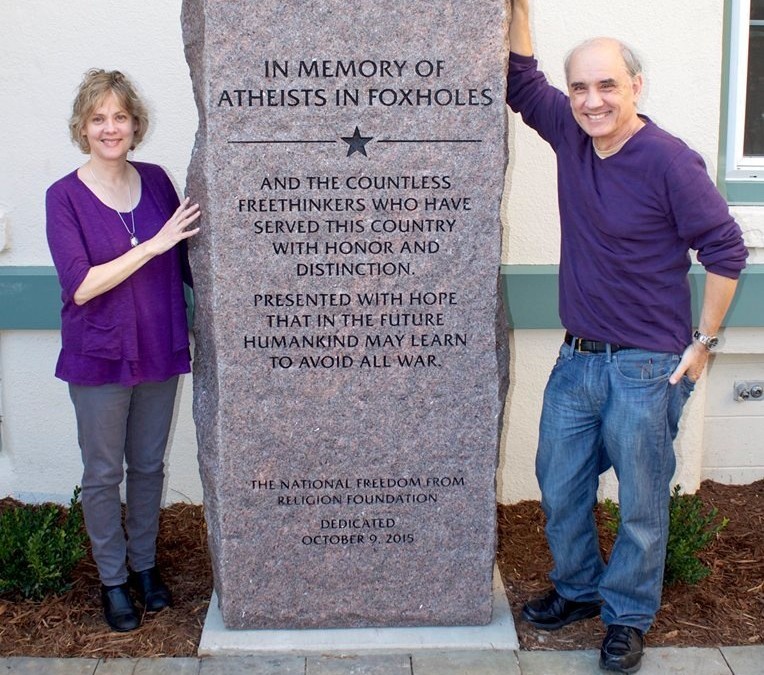
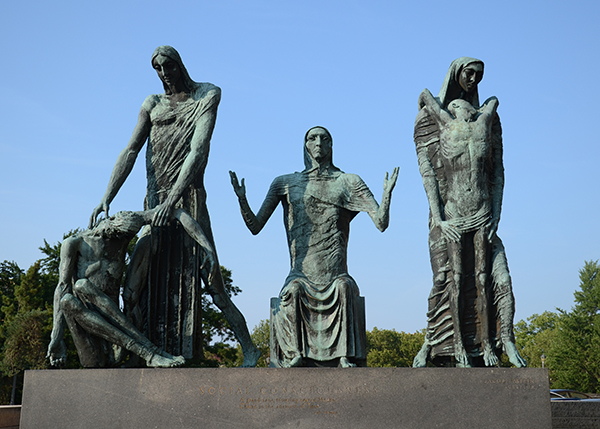
| 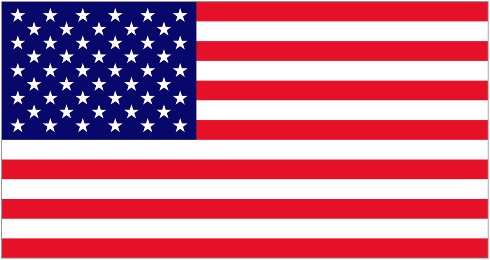  October 9, 2015 - "Atheists in Foxholes" Monument, at Freedom From Religion Foundation (FFRF) headquarters, Madison, Wisconsin (USA). "Contradicts an old jingoistic slogan ('There are no atheists in foxholes.') that proclaims no secular person could, or would, give their lives on the battlefield in the name of the United States. /// Inscribed: 'In memory of atheist in foxholes and the countless freethinkers who have served this country with honor and distinction. Presented with hope that in the future humankind may learn to avoid all war.'" /// This is "Monday's Monument" #42. October 9, 2015 - "Atheists in Foxholes" Monument, at Freedom From Religion Foundation (FFRF) headquarters, Madison, Wisconsin (USA). "Contradicts an old jingoistic slogan ('There are no atheists in foxholes.') that proclaims no secular person could, or would, give their lives on the battlefield in the name of the United States. /// Inscribed: 'In memory of atheist in foxholes and the countless freethinkers who have served this country with honor and distinction. Presented with hope that in the future humankind may learn to avoid all war.'" /// This is "Monday's Monument" #42.
|

August 11, 2016
|

October 28, 1911
|
S
T
A
T
U
E |   - Statue of Robert Ingersoll, Glen Oak Park, Peoria, Illinois (USA). Robert G. Ingersoll [1833-1899] was a lawyer, Civil War veteran, political leader & orator during the Golden Age of Free Thought (roughly 1875-1914). Noted for his broad range of culture & his defense of agnosticism, Ingersoll was nicknamed "The Great Agnostic." Sculpted in 1909 by Fritz Triebel [1865-1948] in Genoa, Italy. "Eugene Baldwin [1843-1914], founder of The Peoria Star, labored long & hard to bring the statue to Peoria." The Freedom from Religion Foundation (FFRF) & Center for Inquiry (CFI) restored the statue & rededicated it on August 11, 2016 (Ingersoll's 183th birthday). See Ingersoll's restored birthplace in Dresden, New York. - Statue of Robert Ingersoll, Glen Oak Park, Peoria, Illinois (USA). Robert G. Ingersoll [1833-1899] was a lawyer, Civil War veteran, political leader & orator during the Golden Age of Free Thought (roughly 1875-1914). Noted for his broad range of culture & his defense of agnosticism, Ingersoll was nicknamed "The Great Agnostic." Sculpted in 1909 by Fritz Triebel [1865-1948] in Genoa, Italy. "Eugene Baldwin [1843-1914], founder of The Peoria Star, labored long & hard to bring the statue to Peoria." The Freedom from Religion Foundation (FFRF) & Center for Inquiry (CFI) restored the statue & rededicated it on August 11, 2016 (Ingersoll's 183th birthday). See Ingersoll's restored birthplace in Dresden, New York. 
|
 
 |   July 14, 2017 - Statue of Clarence Darrow, Rhea County Courthouse, Dayton, Tennessee (USA). By Pennsylvania sculptor Zenos Frudakis. Stands opposite a statue of William Jennings Bryan erected in 2005. Lawyers Clarence Darrow [1857-1938] & William Jennings Bryan [1860-1925] were opponents in the 1925 "Monkey Trial" of high school teacher John T. Scopes [1900-1970] who was convicted of teaching evolution. "The Darrow statue project was paid for in part from money raised by the American Humanist Association, a nontheistic organization that strives 'to bring about a progressive society where being good without a god is an accepted & respected way to live life,' according to its website." July 14, 2017 - Statue of Clarence Darrow, Rhea County Courthouse, Dayton, Tennessee (USA). By Pennsylvania sculptor Zenos Frudakis. Stands opposite a statue of William Jennings Bryan erected in 2005. Lawyers Clarence Darrow [1857-1938] & William Jennings Bryan [1860-1925] were opponents in the 1925 "Monkey Trial" of high school teacher John T. Scopes [1900-1970] who was convicted of teaching evolution. "The Darrow statue project was paid for in part from money raised by the American Humanist Association, a nontheistic organization that strives 'to bring about a progressive society where being good without a god is an accepted & respected way to live life,' according to its website."
|
Please email your comments & questions to geovisual at comcast.net. Thank you.
Return to Peace Monuments main page.






February 17, 1600 - This date is "considered the beginning of the era of modern freethought, as it is marked by the execution in Italy of Giordano Bruno [1548-1600], a former Dominican Monk, by the Inquisition."
October 25, 1600 - Historically the term "Unitarian" first appeared as "unitaria religio" in a document of the Diet of Lécfalva, Transylvania, on 25 Oct. 1600, though it was not widely used in Transylvania till 1638, when the formal recepta Unitaria Religio was published. The Polish Brethren or Socinians did not adopt the name, perhaps because of their differences with the Transylvanian Unitarians, but Christopher Sandius [1644-1680] in 1668 entitled his publication of their works: Bibliotheca Fratrum Polonorum quos Unitarios vocant (Library of the Polish Brethren who are called Unitarians 4 vols. 1665–1669).
1662. - After the restoration of the Stuart monarchy and the resulting Act of Uniformity 1662, around 2000 ministers left the established Church of England. Following the Act of Toleration 1689 many of these ministers preached in 'non-conforming' congregations. The modern Unitarian denomination’s origins lay within this group of respectable Protestants who were reluctant to ever become ’Dissenters,’ i.e. the English Presbyterians.


1673. - The name "Unitarian" is introduced into English in 1673 by the Socinian Henry Hedworth [1626-1705].

1697. The term free-thinker emerged toward the end of the 17th century in England to describe those who stood in opposition to the institution of the Church, and of literal belief in the Bible. The beliefs of these individuals were centered on the concept that people could understand the world through consideration of nature. Freethought positions were formally documented for the first time in 1697 by William Molyneux [1656-1698] in a widely publicized letter to John Locke, and more extensively in 1713, when Anthony Collins [1676-1729] wrote his "Discourse of Free-Thinking," which gained substantial popularity.


1765. In France, the freethought concept first appeared in publication in 1765 when Denis Diderot, Jean le Rond d'Alembert and Voltaire included an article on Libre-Penseur in their Encyclopédie. The European freethought concepts spread so widely that even places as remote as the Jotunheimen, in Norway, had well-known freethinkers, such as Jo Gjende, by the 19th century.

1774. - The Unitarian movement gained popularity in the wake of the Enlightenment and, began to become a formal denomination in England in 1774 when Theophilus Lindsey organised meetings with Joseph Priestley. Unitarianism was not fully legal in the United Kingdom until the Doctrine of the Trinity Act 1813.
1774. Hosea Ballou has been called the "father of American Universalism," along with John Murray (minister), who founded the first Universalist church in America in Gloucester, Massachusetts, in 1774. The first General Society [of Univeraalists] was held in 1778.

1785. Annual conventions [of Universalists] start in 1785 with the New England Convention. (In 1804, this convention changed its name to "The General Convention of Universalists in the New England States & Others.") By Massachusetts state law, citizens were taxed to support the Congregational Church of the community where they lived. Sixty-one people in Gloucester left the church to form the Independent Church of Christ, which stood for Universalism. They then refused to pay their taxes. The church they built was seized and sold to pay; however, the Church sued, and in 1786, they won their case.



1793. Universalists "organize."

1815-1848. In Germany, during the period (1815–1848) and before the Revolution of March 1848, the resistance of citizens against the dogma of the church increased. In 1844, under the influence of Johannes Ronge [1813-1887] and Robert Blum, belief in the rights of man, tolerance among men, and humanism grew, and by 1859 they had established the Bund Freireligiöser Gemeinden Deutschlands (Union of Secular Communities in Germany). This union still exists today, and is included as a member in the umbrella organization of free humanists.




1825 - Establistment of the American Unitarian Association (AUA). The AUA's official journal was the Christian Register (1821-1961).



1830's. At its peak in the 1830's, the Universalist Church is reported to have been the 9th largest denomination in the United States.
1848. Transcendentalism began in 1848 as a protest against the general state of culture and society, and in particular, the state of intellectualism at Harvard and the doctrine of the Unitarian church taught at Harvard Divinity School. Among transcendentalists' core beliefs was an ideal spiritual state that "transcends" the physical and empirical and is realized only through the individual's intuition, rather than through the doctrines of established religions. Prominent transcendentalists included Ralph Waldo Emerson, Henry David Thoreau, Walt Whitman, Amos Bronson Alcott, Orestes Brownson, William Henry Channing, James Freeman Clarke, Christopher Pearse Cranch, John Sullivan Dwight, Convers Francis, Margaret Fuller, William Henry Furness, Frederick Henry Hedge, Theodore Parker, Elizabeth Peabody, George Ripley, and Jones Very.
After 1848. Driven by the Revolutions of 1848 in the German states, the 19th century saw an immigration of German freethinkers and anti-clericalists to the United States (see "Forty-Eighters"). In the U.S., they hoped to be able to live by their principles, without interference from government and church authorities. Many Freethinkers settled in German immigrant strongholds, including St. Louis, Indianapolis, Wisconsin, and Texas, where they founded the town of Comfort, Texas, as well as others.
These groups of German Freethinkers referred to their organizations as Freie Gemeinden, or "free congregations." The first Freie Gemeinde was established in St. Louis in 1850. Others followed in Pennsylvania, California, Washington, D.C., New York, Illinois, Wisconsin, Texas, and other states.
Freethinkers tended to be liberal, espousing ideals such as racial, social, and sexual equality, and the abolition of slavery.




About 1856. The Golden Age of Freethought describes the socio-political movement promoting freethought that developed in the mid 19th-century United States. It began around 1856 and lasted at least through the end of the century; author Susan Jacoby places the end of the Golden Age at the start of World War I [in 1914]. The Golden Age was encouraged by the lectures of the extremely popular agnostic orator Robert G. Ingersoll [1833-1899], the popularization of Charles Darwin’s "The Origin of Species," the push for woman’s suffrage, and other political, scientific, and social trends that clashed with religious orthodoxy and caused people to question their traditional ideas about the world.
June 25, 1863. - Universalist Olympia Brown [1835-1926] becomes the first woman in the United States to receive ordination in a national denomination.


After 1865. After the Civil War, the "Forty-Eighters" supported improved labor laws and working conditions. They also advanced the country's cultural and intellectual development in such fields as education, the arts, medicine, journalism, and business.
1866 - Establishment of the Universalist Church in America. "Known from 1866 as the Universalist General Convention, the name was changed to the Universalist Church of America in 1942. In 1961, it merged with the American Unitarian Association to form the Unitarian Universalist Association."
1873. The earliest known secular organization in English Canada is the Toronto Freethought Association, founded in 1873 by a handful of secularists. Reorganized in 1877 and again in 1881, when it was renamed the Toronto Secular Society, the group formed the nucleus of the Canadian Secular Union, established in 1884 to bring together freethinkers from across the country.

1877 - Felix Adler [1851-1933], professor of political & social ethics, rationalist, popular lecturer, religious leader & social reformer, founds Ethical Culture movement. "Individual chapter organizations are generically referred to as "Ethical Societies", though their names may include "Ethical Society," "Ethical Culture Society," "Society for Ethical Culture," "Ethical Humanist Society," or other variations on the theme of "Ethical."
Ethical Culture is premised on the idea that honoring and living in accordance with ethical principles is central to what it takes to live meaningful and fulfilling lives, and to creating a world that is good for all. Practitioners of Ethical Culture focus on supporting one another in becoming better people, and on doing good in the world.
The American Ethical Union is a federation of about 25 Ethical Societies in the United States, representing the Ethical Culture movement. It is one of the founding member organizations of the International Humanist & Ethical Union."
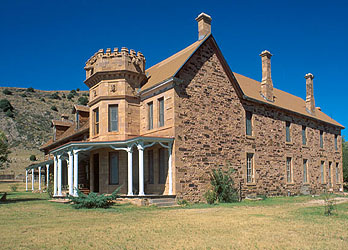



1881. The Freethinker magazine was first published in Britain in 1881.
1881. In Frankfurt am Main, Ludwig Büchner established Deutschen Freidenkerbund (German Freethinkers League) as the first German organization for atheists. In 1892 the Freidenker-Gesellschaft and in 1906 the Deutscher Monistenbund were formed. Freethought organizations developed "Jugendweihe", secular "confirmation" ceremonies, and atheist funeral rites.




About 1890. Freethought in the United States began to decline in the late nineteenth century. Its anti-religious views alienated would-be sympathizers. The movement also lacked cohesive goals or beliefs. By the early 20th century, most Freethought congregations had disbanded or joined other mainstream churches.




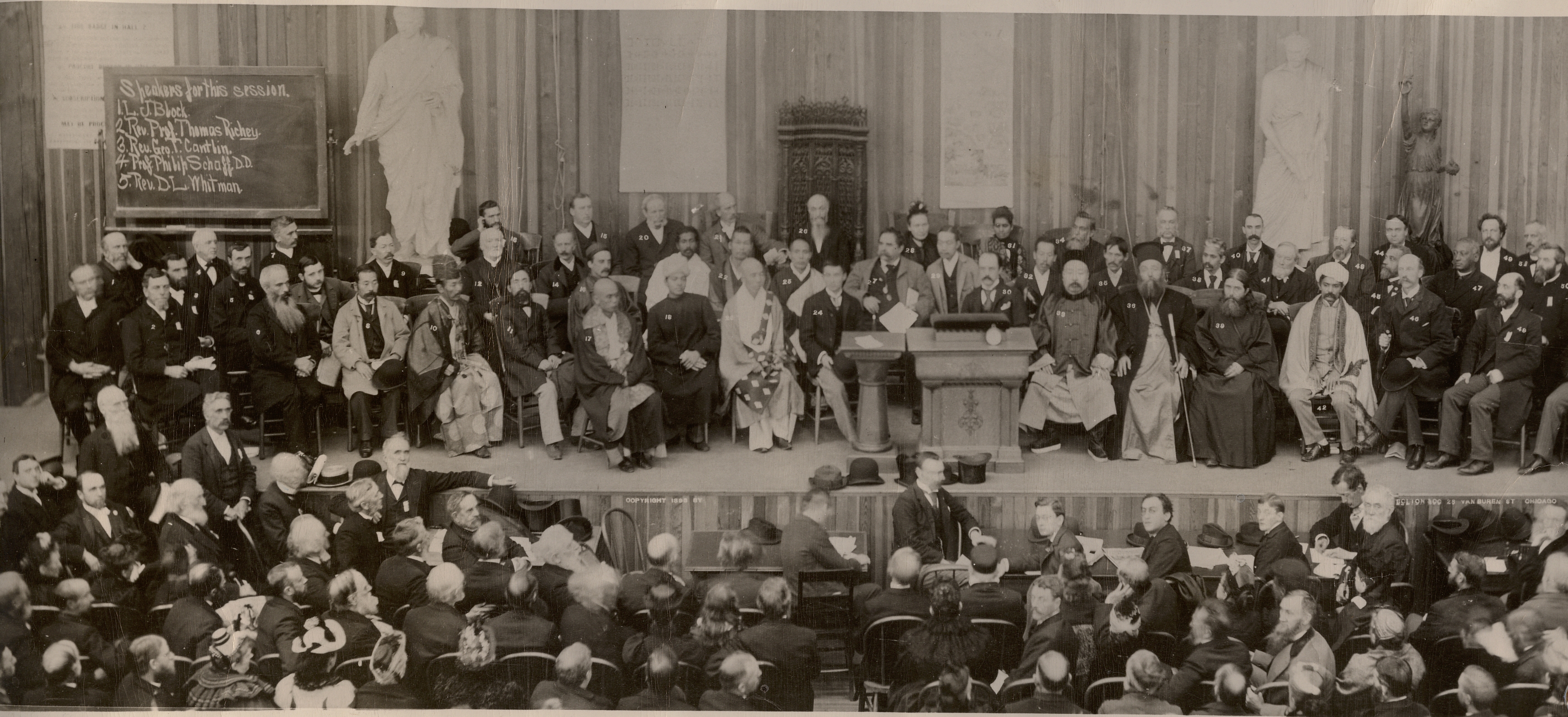
1890's. In the 1890's the American Unitarian Association began to allow non-Christian and non-theistic churches and individuals to be part of their fellowship. As a result, people who held no Unitarian belief began to be called "Unitarians," simply because they were members of churches that belonged to the American Unitarian Association. After several decades, the non-theistic members outnumbered the theological Unitarians.







1905. The Union of Freethinkers for Cremation was founded in 1905, and the Central Union of German Proletariat Freethinker in 1908. The two groups merged in 1927, becoming the German Freethinking Association in 1930. More "bourgeois" organizations declined after World War I, and "proletarian" Freethought groups proliferated, becoming an organization of socialist parties.








By 1920 - There are 88 Universalist women ministers, the largest group in the United States.

1925. - European socialist free-thought groups formed the International of Proletarian Freethinkers (IPF) in 1925. Activists agitated for Germans to disaffiliate from the Church and for secularization of elementary schools; between 1919–21 and 1930–32 more than 2.5 million Germans, for the most part supporters of the Social Democratic and Communist parties, gave up church membership. Conflict developed between radical forces including the Soviet League of the Militant Godless and Social Democratic forces in Western Europe led by Theodor Hartwig and Max Sievers. In 1930, the Soviet and allied delegations, following a walk-out, took over the IPF and excluded the former leaders.


1928. - Formation of the General Assembly of Unitarian & Free Christian Churches (GAUFCC), the umbrella organisation for Unitarian, Free Christian & other liberal religious congregations in the United Kingdom. The GAUFCC has several constituent & related traditions - English Presbyterian, General Baptist, Universalist, Methodist, Unitarian & Unitarian Universalist. The GAUFCC was only formed in 1928, but its denominational roots go back to the Great Ejection of 1662, more particularly to the English Presbyterians. The Non-subscribing Presbyterian Church of Ireland maintains very close links with the GAUFCC.


![]() 1929. - Former Unitarian minister Charles Francis Potter [1885-1962] founds the First Humanist Society of New York. The organization stated as its philosophy a "faith in the supreme value & self-perfectibility of human personality, conceived socially as well as individually." Its advisory board included such notables as Julian Huxley, John Dewey, Albert Einstein & Thomas Mann.
1929. - Former Unitarian minister Charles Francis Potter [1885-1962] founds the First Humanist Society of New York. The organization stated as its philosophy a "faith in the supreme value & self-perfectibility of human personality, conceived socially as well as individually." Its advisory board included such notables as Julian Huxley, John Dewey, Albert Einstein & Thomas Mann.
After 1933. - Following Hitler's rise to power in 1933, most freethought organizations were banned in Germany, though some right-wing groups that worked with Volkisch associations were tolerated by the Nazis until the mid 1930's.
1935 - Fellowship of Humanity is founded by Reverend A. D. Faupell as one of a handful of "humanist churches" seeded in the early 20th century as part of the American Religious Humanism movement. It is the only such organization to survive into the 21st century and is the first & oldest affiliate of the American Humanist Association (AHA)."










1961 - Unitarian Universalism becomes organized as a religious group with establishment of the Unitarian Universalist Association (UUA), a consolidation of the American Unitarian Association (established in 1825) and the Universalist Church in America (established in 1866). It is headquartered in Boston, Massachusetts, and serves churches mostly in the United States. The Canadian Unitarian Council will become an independent body in 2002.







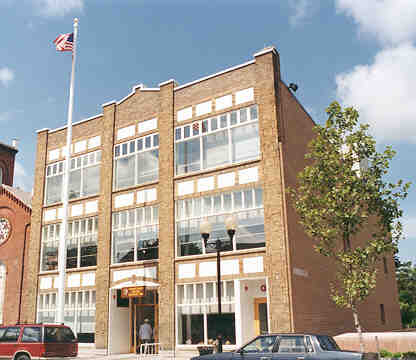






























![]() March 25-26, 2012 - Annual Convention of American Atheists, Bethesda North Marriott & Convention Center, Bethesda, Maryland (USA). "This year's theme: 'Come out! Come out! Wherever you Are!' We will be concentrating this packed-to-the gills convention with help in all aspects of coming out of the atheist closet to your friends, family, and co-workers."
March 25-26, 2012 - Annual Convention of American Atheists, Bethesda North Marriott & Convention Center, Bethesda, Maryland (USA). "This year's theme: 'Come out! Come out! Wherever you Are!' We will be concentrating this packed-to-the gills convention with help in all aspects of coming out of the atheist closet to your friends, family, and co-workers."






